Last Updated 1 month ago
Most Expensive Paintings in the World 2025 – Expensive paintings typically refer to artworks that have fetched high prices at auctions or through private sales. The value of a painting can be influenced by various factors including the artist’s reputation, the historical significance of the artwork, its rarity, condition, provenance (the history of ownership), and prevailing market trends. List can vary depending on the timing of sales and fluctuations in the art market. Additionally, many paintings of great value remain in private collections, their worth often undisclosed to the public.

25 Most Expensive Paintings in the World 2025 – Quick Introduction
| Painting | Price in $ |
|---|---|
| Mona Lisa by Leonardo Da Vinci | $860 Million |
| Salvator Mundi by Leonardo da Vinci | $450 Million |
| Interchange by Willem de Kooning | $300 Million |
| The Card Players by Paul Cézanne | $250 Million |
| Nafea Faa Ipoipo (When Will You Marry?) by Paul Gauguin | $210 Million |
| Number 17A by Jackson Pollock | $200 Million |
| Shot Sage Blue Marilyn by Andy Warhol | $195 Million |
| No. 6 (Violet, Green and Red) by Mark Rothko | $186 Million |
| Water Serpents II by Gustav Klimt | $183 Million |
| Pendant portraits of Maerten Soolmans and Oopjen Coppit by Rembrandt | $180 Million |
| Les Femmes d’Alger (Version O) by Pablo Picasso | $179 Million |
| The Standard Bearer by Rembrandt | $175 Million |
| Masterpiece by Roy Lichtenstein | $165 Million |
| Nu couché (Reclining Nude) by Amedeo Modigliani | $157 Million |
| Le Rêve by Pablo Picasso | $155 Million |
| Portrait of Adele Bloch-Bauer II by Gustav Klimt | $150 Million |
| Three Studies of Lucian Freud by Francis Bacon | $142 Million |
| Woman III by Willem de Kooning | $137 Million |
| Portrait of Adele Bloch-Bauer I by Gustav Klimt | $135 Million |
| Silver Car Crash (Double Disaster) by Andy Warhol | $105 Million |
| Portrait of Dr. Gachet by Vincent van Gogh | $82 Million |
| Water Lily Pond by Claude Monet | $80 Million |
| Bal du moulin de la Galette by Pierre-Auguste Renoir | $78 Million |
| Untitled XXV by Willem de Kooning | $66 Million |
25 Most Expensive Paintings in the World 2025 – Brief Introduction
Mona Lisa by Leonardo Da Vinci
Price is approx. $860 Million on 2023
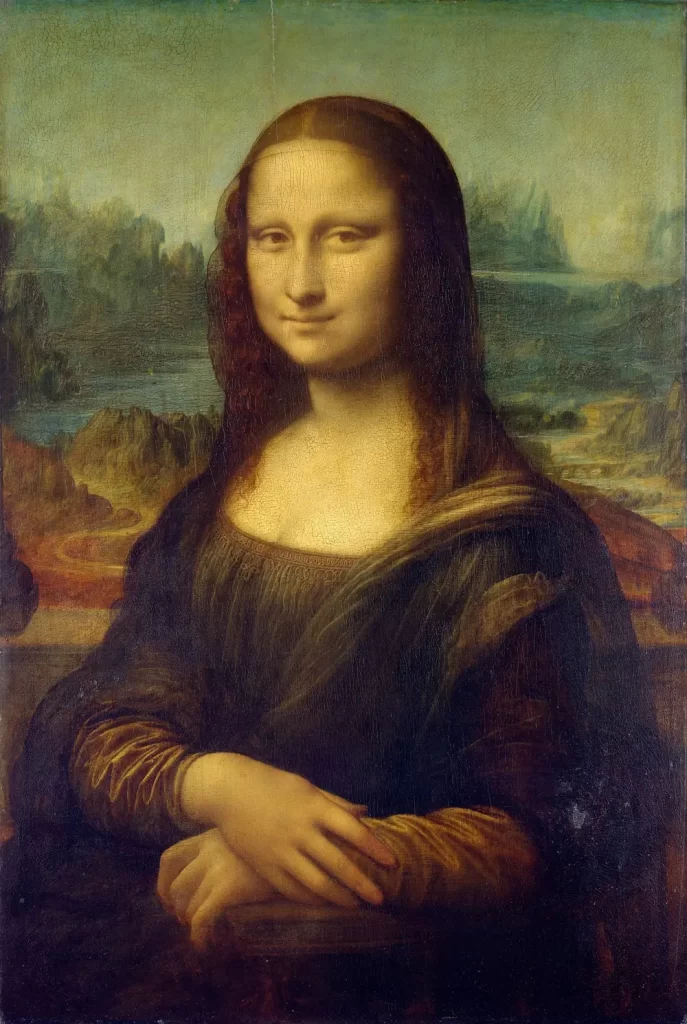
Introduction
The Mona Lisa, created by the renowned Italian polymath Leonardo da Vinci, stands as an iconic symbol of artistry, mystery, and intrigue. Completed in the early 16th century, this enigmatic portrait has captured the imagination of viewers for centuries, drawing countless admirers to marvel at its subtle beauty and elusive smile.
Description
Measuring approximately 30 x 21 inches, the Mona Lisa is an oil painting on a poplar wood panel. Its subject, believed to be Lisa Gherardini, the wife of Florentine merchant Francesco del Giocondo, gazes serenely at the viewer, her expression veiled in an aura of ambiguity. Da Vinci’s meticulous attention to detail is evident in every brushstroke, from the delicate rendering of the sitter’s hands to the atmospheric perspective of the landscape behind her.
Technique
Leonardo da Vinci employed a groundbreaking technique known as sfumato, which involves the subtle blending of colors and tones to create soft, seamless transitions between light and shadow. This technique imbues the Mona Lisa with a sense of depth and realism, enhancing its timeless allure and contributing to its status as a masterpiece of the Renaissance era.
Price
While the Mona Lisa’s true value is immeasurable in cultural and historical terms, it has been appraised at an estimated insurance value of over $800 million, making it one of the most valuable paintings in the world. However, its priceless nature transcends monetary considerations, embodying the pinnacle of artistic achievement and human creativity.
Painter
Leonardo da Vinci, a visionary artist, scientist, and inventor of the Italian Renaissance, is credited with the creation of the Mona Lisa. His unparalleled mastery of anatomy, perspective, and light enabled him to infuse the painting with a sense of lifelike vitality and emotional depth, cementing his legacy as one of the greatest artists in history.
Location
The Mona Lisa is housed in the Louvre Museum in Paris, France, where it has resided since 1797. Displayed in a climate-controlled environment within a specially designed enclosure, the painting is protected from fluctuations in temperature and humidity, ensuring its preservation for future generations to admire and study.
Accessibility
As one of the Louvre’s most prized possessions, the Mona Lisa is a must-see attraction for visitors from around the world. While its popularity can result in crowded viewing conditions, the museum employs various measures to ensure that visitors have the opportunity to appreciate the painting up close, including designated viewing areas and timed entry slots.
Conclusion
In conclusion, the Mona Lisa stands as a testament to the enduring power of art to captivate, inspire, and transcend the boundaries of time and space. Its enigmatic smile continues to fascinate scholars, artists, and spectators alike, inviting us to ponder the mysteries of human perception and the boundless depths of the human soul.
As a cultural treasure of unparalleled significance, the Mona Lisa remains an enduring symbol of Leonardo da Vinci’s genius and the limitless potential of the artistic imagination. In the contest of 25 Most Expensive Paintings in the World, Mona Lisa by Leonardo Da Vinci claims the 1st position.
Salvator Mundi by Leonardo Da Vinci
Price is approx. $450 Million on 2017
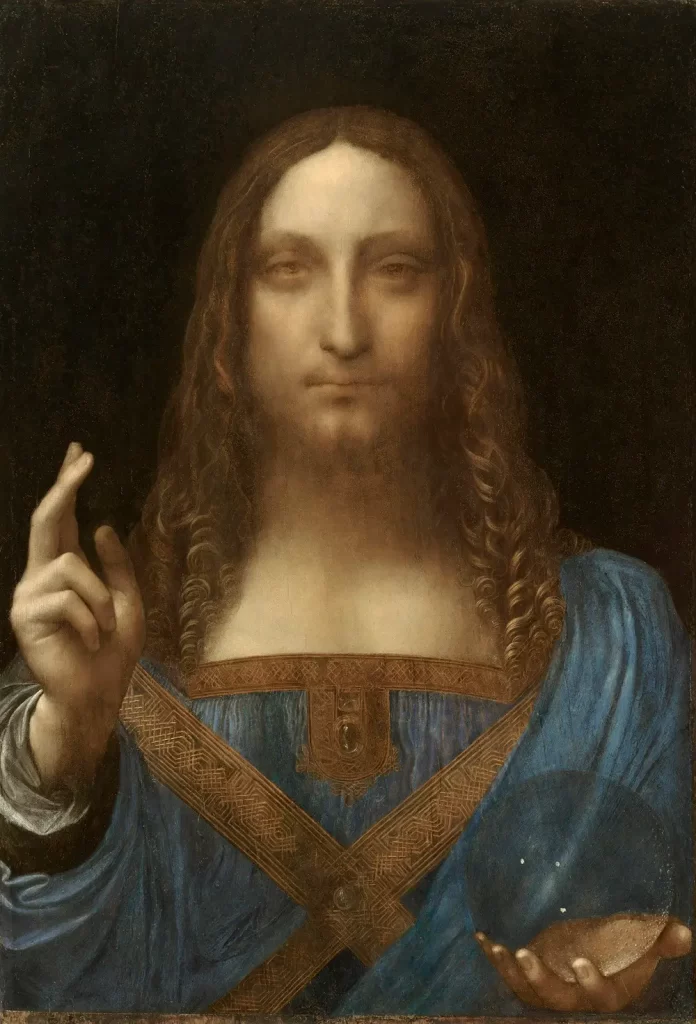
Introduction
Leonardo da Vinci’s “Salvator Mundi” stands as one of the most captivating and enigmatic masterpieces in the history of art. This iconic painting, believed to have been created around 1500 AD, mesmerizes viewers with its profound symbolism, exquisite technique, and mysterious allure. As we delve into the depths of this artistic marvel, we uncover layers of intrigue that continue to fascinate scholars and art enthusiasts alike.
Description
“Salvator Mundi,” translated as “Savior of the World,” depicts Christ as the divine ruler of the universe. In the painting, Christ gazes serenely at the viewer, his right hand raised in blessing while holding a transparent orb representing the celestial sphere. His left hand cradles a delicate crystal globe, symbolizing his dominion over the earthly realm. The figure is rendered with remarkable realism, showcasing Leonardo’s mastery of light, shadow, and anatomical precision. Every detail, from the intricate drapery of Christ’s robes to the subtle reflection in his eyes, exudes a sense of transcendent beauty and grace.
Technique
Leonardo da Vinci employed his signature sfumato technique in “Salvator Mundi,” blending layers of translucent glazes to create a soft, atmospheric effect. The seamless transition between light and shadow imbues the painting with a sense of ethereality, enhancing the otherworldly presence of the figure. Leonardo’s meticulous attention to detail is evident in the intricacies of the painting, from the delicate curls of Christ’s hair to the intricate patterns of his garments.
Price
In 2017, “Salvator Mundi” made headlines when it sold at auction for a record-breaking $450.3 million, making it the most expensive painting ever sold. This staggering price tag reflects not only the painting’s artistic significance but also its rarity and historical importance. The astronomical sum paid for “Salvator Mundi” underscores its status as a cultural treasure of unparalleled value.
Painter
Attributed to Leonardo da Vinci, “Salvator Mundi” is believed to be the work of the Italian Renaissance master himself. While the painting’s exact origins have been the subject of debate among scholars, recent research and technical analysis have provided compelling evidence supporting its attribution to Leonardo. If authenticated, “Salvator Mundi” would be one of fewer than 20 surviving paintings by the renowned artist.
Location
Following its sale in 2017, the current location of “Salvator Mundi” remains shrouded in mystery. Speculation abounds regarding the painting’s whereabouts, with rumors circulating about private collectors and undisclosed galleries. The elusive nature of its location only adds to the intrigue surrounding this iconic masterpiece.
Accessibility
Unfortunately, the accessibility of “Salvator Mundi” to the public remains limited due to its uncertain whereabouts. While art enthusiasts around the world eagerly await the opportunity to view this extraordinary painting in person, its elusive status underscores the challenges of preserving and sharing cultural heritage on a global scale.
Conclusion
Leonardo da Vinci’s “Salvator Mundi” continues to captivate and inspire audiences centuries after its creation. As a testament to the genius of one of history’s greatest artists, this extraordinary painting transcends time and space, inviting viewers to contemplate the divine mysteries it embodies.
Whether through its exquisite technique, profound symbolism, or astronomical price tag, “Salvator Mundi” remains an enduring symbol of humanity’s quest for beauty, truth, and transcendence. In the contest of 25 Most Expensive Paintings in the World, Salvator Mundi by Leonardo Da Vinci claims the 2nd position.
Interchange by Willem De Kooning
Price is approx. $300 Million on 2015
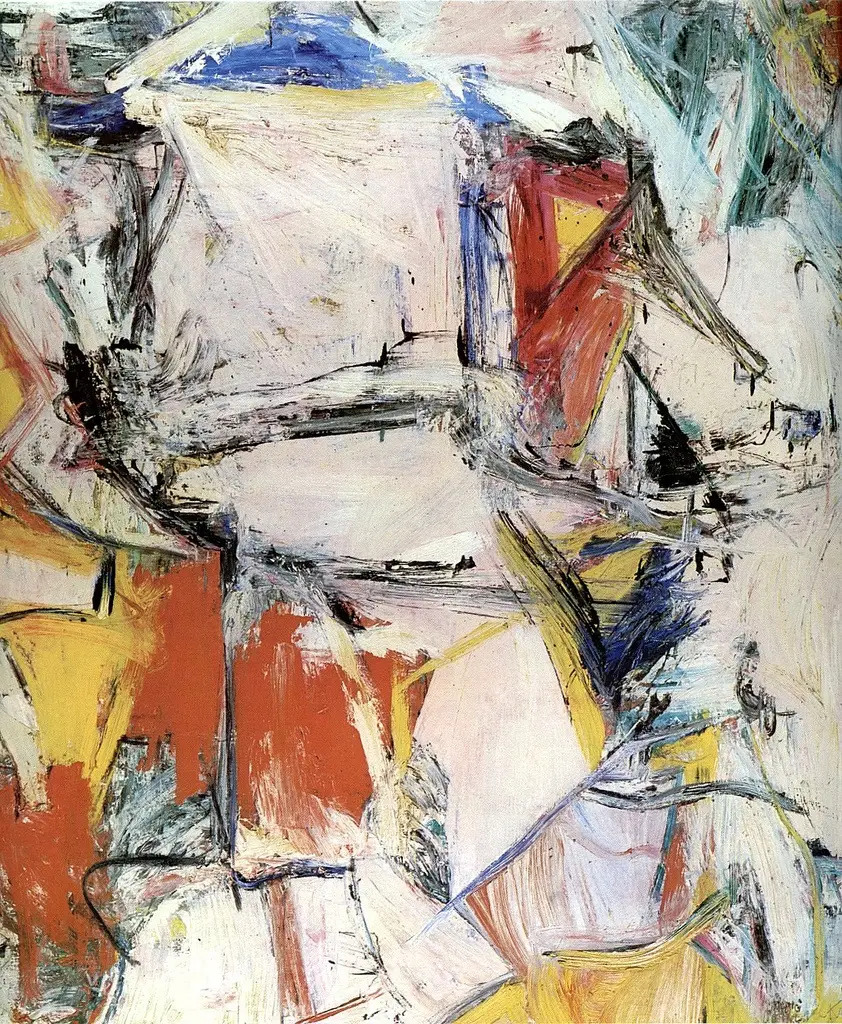
Introduction
Willem de Kooning, a pivotal figure in the Abstract Expressionist movement, created “Interchange” in 1955. This monumental painting stands as a testament to de Kooning’s mastery of abstract expressionism and his ability to convey a sense of dynamism and emotion through vibrant colors and gestural brushwork.
Description
“Interchange” is an expansive canvas measuring 79 x 69 inches, filled with swirling forms and bold strokes of color. De Kooning’s signature style is evident in the fluidity of the composition, where shapes seem to merge and evolve, blurring the lines between figure and ground. The use of contrasting colors, such as vibrant yellows, deep blues, and fiery reds, adds to the intensity of the painting, creating a sense of energy and movement that captivates the viewer’s attention.
Technique
De Kooning employed a variety of techniques to create the rich texture and dynamic quality of “Interchange.” His process involved layering and scraping paint, allowing for spontaneous gestures and improvisation on the canvas. The result is a visually complex work that invites viewers to explore its depths and interpret its meaning in their own unique way.
Price
As one of de Kooning’s most iconic works, “Interchange” holds significant value in the art market. While exact prices for such masterpieces can vary depending on factors such as provenance and condition, notable sales of de Kooning’s works have reached tens of millions of dollars at auction.
Painter
Willem de Kooning, born in Rotterdam, Netherlands, in 1904, emerged as one of the leading figures of the Abstract Expressionist movement in the mid-20th century. Known for his bold experimentation with form and color, de Kooning’s works continue to influence generations of artists and art enthusiasts worldwide.
Location
“Interchange” is part of the permanent collection of the Museum of Modern Art (MoMA) in New York City. Its prominent placement within the museum allows visitors to experience firsthand the power and beauty of de Kooning’s artistic vision.
Accessibility
As a renowned institution, MoMA is committed to making art accessible to all audiences. “Interchange” can be viewed by visitors during regular museum hours, offering an opportunity for art lovers and scholars alike to engage with this masterpiece in person. Additionally, MoMA’s online resources provide virtual access to “Interchange” for those unable to visit the museum in person.
Conclusion
“Interchange” by Willem de Kooning stands as a testament to the artist’s innovative spirit and enduring legacy in the world of abstract expressionism. Its dynamic composition, vibrant colors, and emotional depth continue to captivate viewers, inviting them to explore the boundless possibilities of artistic expression.
As a cornerstone of MoMA’s collection, “Interchange” ensures that de Kooning’s artistic vision will inspire and enchant audiences for generations to come. In the contest of 25 Most Expensive Paintings in the World, Interchange by Willem De Kooning claims the 3rd position.
The Card Players by Paul Cézanne
Price is approx. $250 Million on 2011
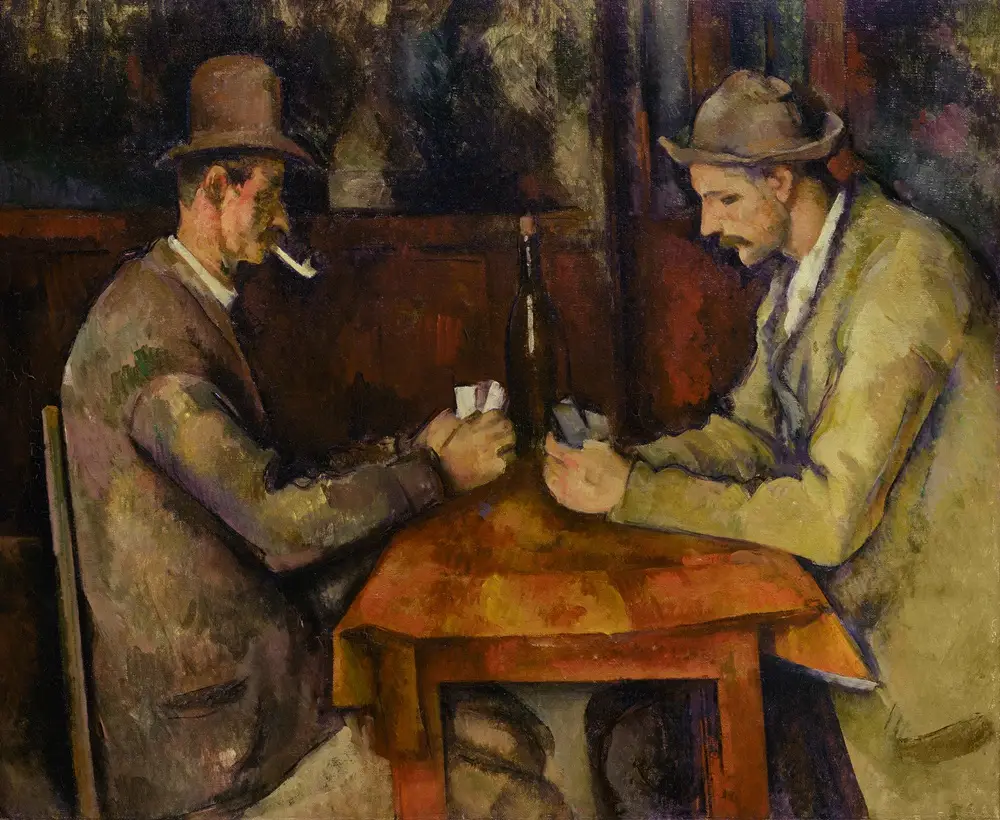
Introduction
“The Card Players” is a series of paintings by the renowned French artist Paul Cézanne. Completed between 1890 and 1895, this series is considered one of Cézanne’s most iconic and influential works. It captures the essence of rural life in Provence, depicting peasants engaged in a game of cards, a common pastime in 19th-century France.
Description
In these paintings, Cézanne presents various compositions of individuals sitting around a table, deeply engrossed in their card game. The figures are typically portrayed in simple, rustic attire, with rough hands and weathered faces, reflecting the hardships of rural life. Cézanne’s meticulous attention to detail and his innovative use of color and form imbue these scenes with a sense of quiet intensity and psychological depth.
Technique
Cézanne is celebrated for his revolutionary approach to painting, which bridged the gap between Impressionism and Cubism. In “The Card Players,” he employed a unique blend of brushwork and geometric abstraction to create a sense of solidity and volume in his subjects. His use of light and shadow adds a dramatic dimension to the compositions, enhancing the overall realism of the scenes.
Price
Given their significance in the history of art and their rarity, original works from the “Card Players” series command exceptionally high prices in the art market. Some paintings from this series have fetched tens of millions of dollars at auction, making them highly coveted by collectors and institutions alike.
Painter
Paul Cézanne (1839–1906) was a pioneering figure in the development of modern art. His innovative approach to color, form, and composition laid the groundwork for many 20th-century art movements, including Cubism and Fauvism. Despite facing rejection and criticism during his lifetime, Cézanne’s work ultimately earned him widespread acclaim and recognition as one of the greatest artists of all time.
Location
Works from the “Card Players” series can be found in prominent museums and private collections around the world. Institutions such as the Musée d’Orsay in Paris, the Metropolitan Museum of Art in New York, and the Courtauld Gallery in London house some of Cézanne’s most celebrated paintings, including pieces from this series.
Accessibility
While viewing original works from the “Card Players” series may require a visit to a museum or gallery, reproductions and digital images of these paintings are widely accessible online. Many art books and publications also feature reproductions of Cézanne’s work, allowing art enthusiasts to explore and appreciate his mastery from anywhere in the world.
Conclusion
“The Card Players” by Paul Cézanne stands as a testament to the artist’s genius and his profound impact on the course of modern art. Through these paintings, Cézanne captured the timeless essence of human interaction and rural life, while also pushing the boundaries of artistic expression.
Today, these iconic works continue to inspire and captivate audiences around the globe, solidifying Cézanne’s legacy as a true master of his craft. In the contest of 25 Most Expensive Paintings in the World, The Card Players by Paul Cézanne claims the 4th position.
Nafea Faa Ipoipo (When Will You Marry?) by Paul Gauguin
Price is approx. $210 Million on 2015
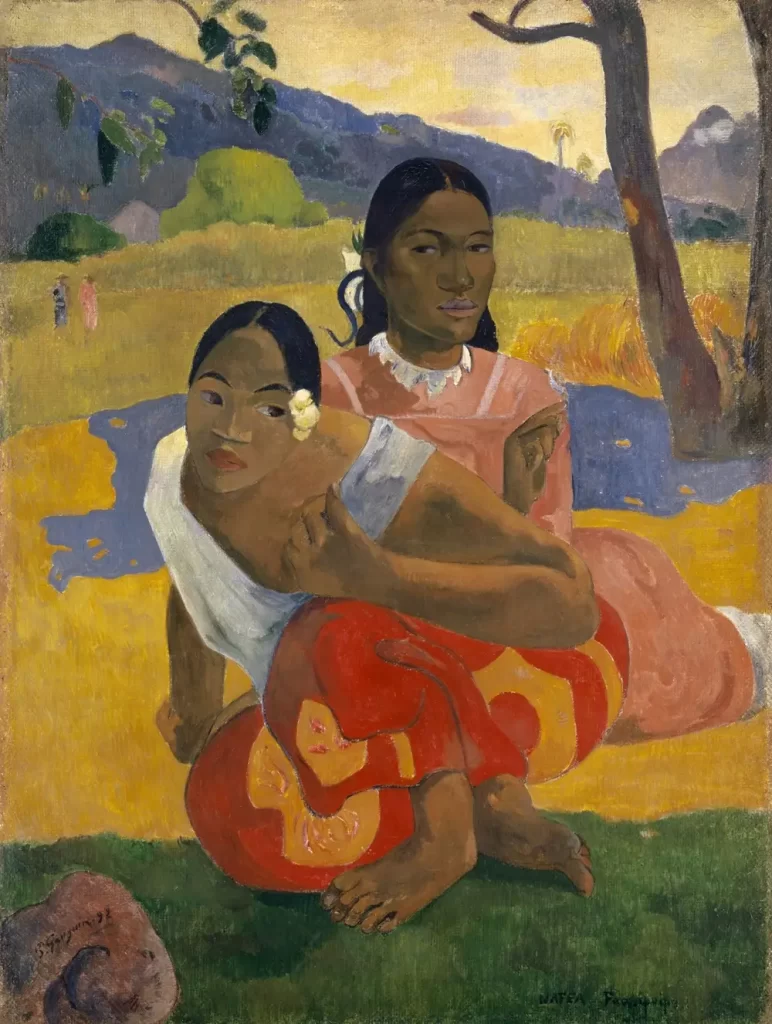
Introduction
“Nafea Faa Ipoipo,” translated as “When Will You Marry?” is an iconic masterpiece painted by the renowned French Post-Impressionist artist, Paul Gauguin. Completed in 1892 during Gauguin’s stay in Tahiti, this painting is emblematic of his exploration of exoticism and the indigenous culture of Polynesia. It stands as a significant piece in the history of art, capturing Gauguin’s fascination with Tahitian life and his unique artistic vision.
Description
“Nafea Faa Ipoipo” portrays two Tahitian women seated in a lush tropical landscape. The figures are depicted in traditional attire, surrounded by vibrant flora and fauna characteristic of the Polynesian environment. The women’s enigmatic gazes invite viewers into their world, while the subtle nuances of color and form convey a sense of tranquility and mystery. Gauguin’s distinctive style, characterized by bold outlines, simplified forms, and unconventional use of color, is evident in this composition, adding to its allure and timelessness.
Technique
Gauguin employed various techniques to create “Nafea Faa Ipoipo,” including a combination of bold brushstrokes and delicate detailing. He utilized a vibrant color palette dominated by warm hues, such as deep reds, lush greens, and golden yellows, to evoke the richness of the Tahitian landscape. The artist’s use of flat areas of color and simplified forms contributes to the painting’s overall sense of harmony and balance.
Price
In 2015, “Nafea Faa Ipoipo” made headlines when it was sold privately for a staggering $210 million, making it one of the most expensive artworks ever sold. This record-breaking sale reflects the painting’s significance in the art world and its enduring appeal to collectors and enthusiasts alike.
Painter
Paul Gauguin, a leading figure of the Post-Impressionist movement, is celebrated for his innovative approach to color and form. Born in Paris in 1848, Gauguin embarked on a transformative artistic journey that led him to Tahiti, where he found inspiration in the island’s culture and landscape. His works, including “Nafea Faa Ipoipo,” continue to captivate audiences with their emotive power and visual brilliance.
Location
“Nafea Faa Ipoipo” is currently housed in the collection of the Qatar Museums in Doha, Qatar. As a part of the museum’s holdings, the painting is accessible to visitors who wish to experience Gauguin’s masterful interpretation of Tahitian life and culture.
Accessibility
While “Nafea Faa Ipoipo” may not be easily accessible to all due to its location in Qatar, reproductions and images of the painting are widely available in books, online resources, and exhibitions around the world. These avenues allow art enthusiasts to appreciate Gauguin’s masterpiece and delve into its complexities from afar.
Conclusion
“Nafea Faa Ipoipo” stands as a testament to Paul Gauguin’s artistic genius and his enduring fascination with the exoticism of Tahitian culture. Through its enchanting depiction of two Tahitian women, the painting invites viewers to contemplate themes of identity, spirituality, and the relationship between humanity and nature.
Its record-breaking sale and continued relevance in the art world underscore its status as a timeless masterpiece that continues to inspire and captivate audiences worldwide. In the contest of 25 Most Expensive Paintings in the World, Nafea Faa Ipoipo by Paul Gauguin claims the 5th position.
Number 17A by Jackson Pollock
Price is approx. $200 Million on 2015
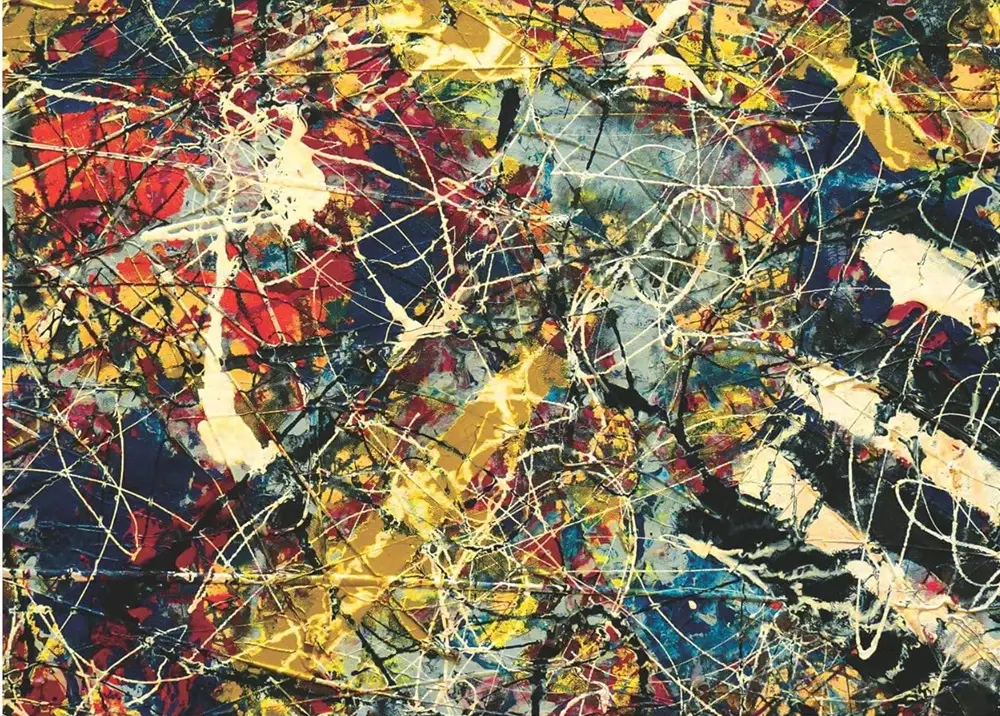
Introduction
“Number 17A” by Jackson Pollock stands as a hallmark of Abstract Expressionism, a movement that revolutionized the art world in the mid-20th century. For 10th-grade students, delving into this masterpiece offers a window into the realm of abstract art, the techniques employed by Pollock, and the significance of his works in the art world.
Description of the Painting
“Number 17A” is a large-scale painting, characteristic of Pollock’s drip painting technique. Created in 1948, it measures approximately 220.3 × 488.9 cm and is housed at the Museum of Modern Art (MoMA) in New York City. The canvas is a chaotic dance of colors, lines, and textures, created through the artist’s unconventional method of pouring and dripping paint onto the canvas.
Exploring Abstract Expressionism
Abstract Expressionism emerged in the 1940s and 1950s as a response to the tumultuous socio-political climate of the time. Artists like Jackson Pollock sought to express inner emotions and subconscious thoughts through their art, rejecting traditional forms of representation in favor of abstraction. “Number 17A” epitomizes the movement’s emphasis on spontaneity, emotion, and the artist’s gestural expression.
Understanding Pollock’s Technique
Pollock’s drip technique involved laying a canvas on the floor and applying paint directly from cans or brushes, allowing it to flow and splatter in a controlled yet seemingly random manner. This method liberated the artist from the constraints of traditional brushwork, enabling a direct and visceral connection between Pollock and his canvas. Through this process, he captured the raw energy and dynamism of his emotions.
Interpreting the Painting
“Number 17A” invites viewers to interpret its meaning subjectively, as is typical of abstract art. Some may see chaotic energy or a sense of movement, while others may find moments of tranquility or introspection within the swirling layers of paint. Encouraging students to engage with the painting on a personal level fosters critical thinking and creativity, allowing them to develop their own interpretations and perspectives.
Price and Painter’s Specialty
As of its last public valuation, “Number 17A” by Jackson Pollock holds an estimated value of over $200 million, making it one of the most valuable paintings in the world. Pollock’s unique style and contribution to Abstract Expressionism have cemented his legacy as one of the most influential artists of the 20th century.
Location and Accessibility
“Number 17A” is currently on display at the Museum of Modern Art (MoMA) in New York City, providing students with the opportunity to experience it firsthand. For those unable to visit in person, digital resources and virtual tours offer alternative ways to explore the painting and its significance from anywhere in the world.
Conclusion
“Number 17A” by Jackson Pollock serves as a gateway for 10th-grade students to explore the world of abstract art and the principles of Abstract Expressionism. Through its vibrant colors, dynamic composition, and rich history, the painting offers a captivating journey into the realm of artistic expression, encouraging students to embrace creativity, critical thinking, and the power of interpretation. In the contest of 25 Most Expensive Paintings in the World, Number 17A by Jackson Pollock claims the 6th position.
Shot Sage Blue Marilyn by Andy Warhol
Price is approx. $195 Million on 2022
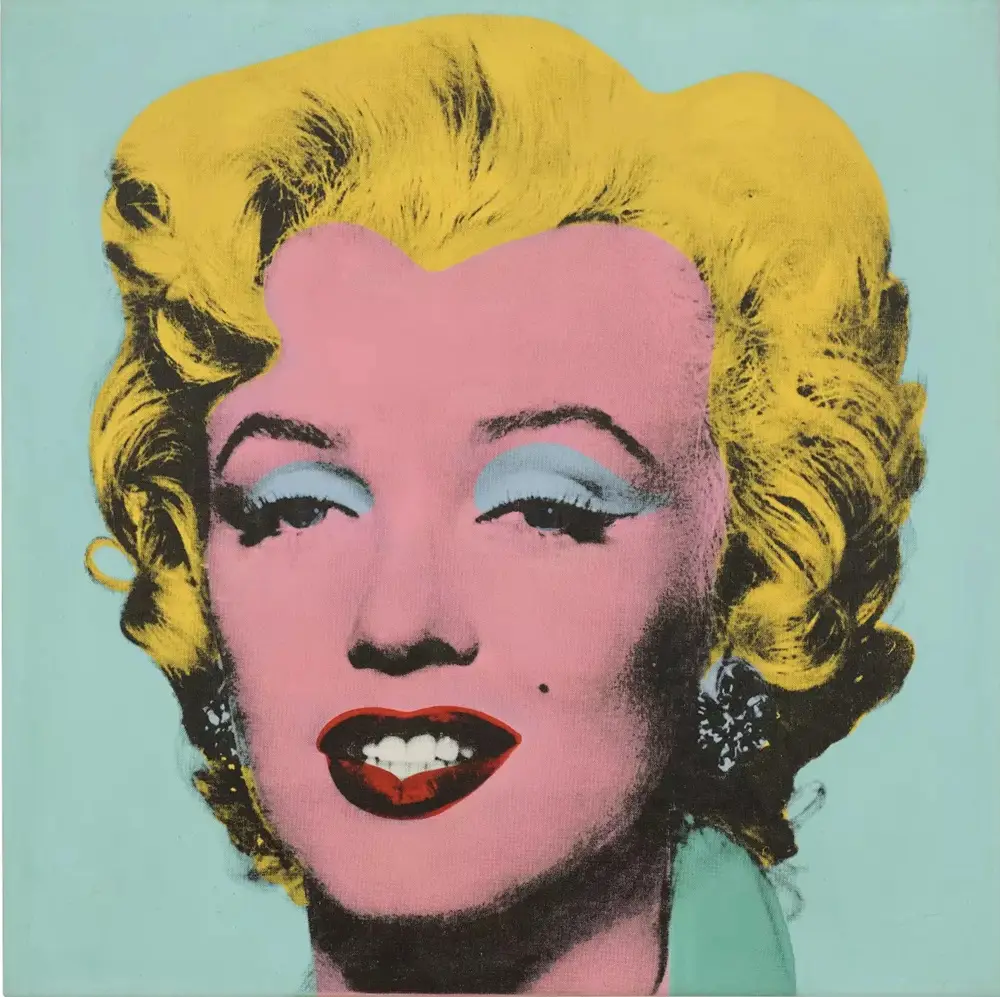
Introduction
“Shot Sage Blue Marilyn” is an iconic artwork created by the renowned American artist Andy Warhol. This piece is part of Warhol’s series of Marilyn Monroe portraits, which have become emblematic of both the Pop Art movement and celebrity culture in the 20th century.
Description
“Shot Sage Blue Marilyn” depicts Marilyn Monroe, the quintessential Hollywood star, in Warhol’s distinctive style. Warhol employed his trademark silk-screening technique, using bright and contrasting colors to create a striking and memorable image. In this particular artwork, Monroe’s visage is rendered in shades of blue, adding a sense of depth and melancholy to the portrayal of the glamorous actress.
Technique
Andy Warhol revolutionized the art world with his innovative use of mass production techniques, particularly silk-screening. This allowed him to replicate images multiple times while introducing variations in color and composition. In “Shot Sage Blue Marilyn,” Warhol’s mastery of this technique is evident in the crisp lines and bold colors that define Monroe’s iconic features.
Price
As with many of Warhol’s works, the value of “Shot Sage Blue Marilyn” can vary greatly depending on factors such as its condition, provenance, and the current state of the art market. However, given its significance within Warhol’s oeuvre and the enduring popularity of Monroe as a cultural icon, it is likely to command a substantial price at auction or in private sales.
Painter
Andy Warhol (1928–1987) was an American artist, filmmaker, and leading figure in the Pop Art movement. His exploration of consumer culture, celebrity, and mass media has had a profound influence on contemporary art. Warhol’s diverse body of work includes paintings, prints, sculptures, and experimental films, all of which continue to captivate audiences around the world.
Location
The current location of “Shot Sage Blue Marilyn” may vary depending on whether it is part of a private collection, museum exhibition, or gallery inventory. However, Warhol’s works are featured in prestigious institutions and private collections worldwide, ensuring that his artistic legacy remains accessible to audiences across the globe.
Accessibility
Access to “Shot Sage Blue Marilyn” may be limited to specific exhibitions, galleries, or collections where the artwork is on display. However, reproductions and images of the piece are widely available online and in publications dedicated to Warhol’s art. Virtual exhibitions and digital archives also offer opportunities for audiences to engage with Warhol’s work from the comfort of their own homes.
Conclusion
“Shot Sage Blue Marilyn” exemplifies Andy Warhol’s ability to transform everyday images into iconic works of art that continue to resonate with audiences decades after their creation. Through his innovative techniques and fascination with celebrity culture, Warhol challenged traditional notions of art and revolutionized the way we perceive and interact with visual media.
As a testament to his enduring influence, “Shot Sage Blue Marilyn” remains a celebrated and cherished masterpiece in the annals of contemporary art history. In the contest of 25 Most Expensive Paintings in the World, Shot Sage Blue Marilyn by Andy Warhol claims the 7th position.
No. 6 (Violet, Green and Red) by Mark Rothko
Price is approx. $186 Million on 2014
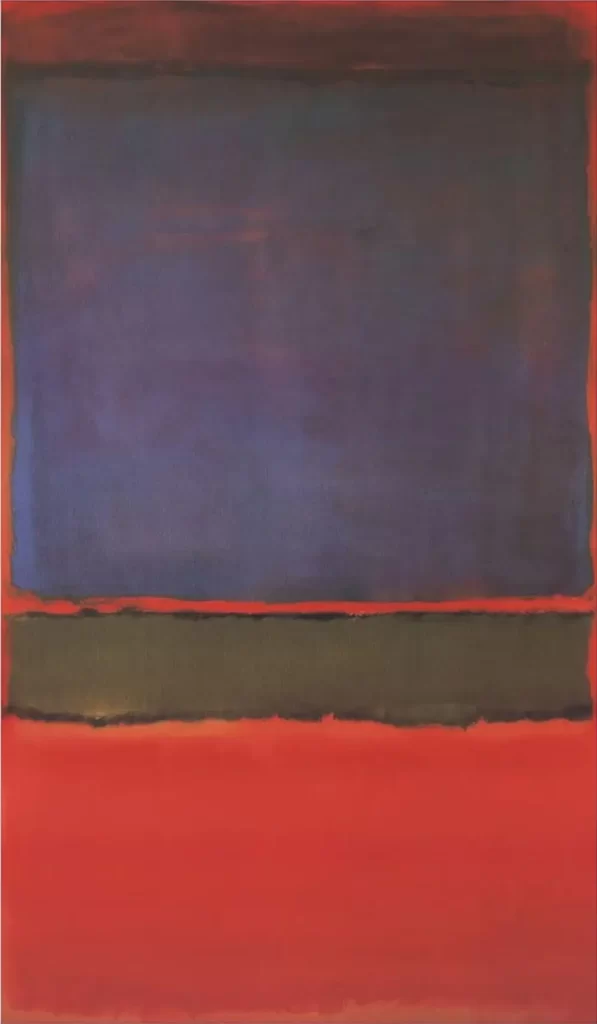
Introduction
Mark Rothko, a prominent figure in the Abstract Expressionist movement, created “No. 6 (Violet, Green and Red)” in 1951. This masterpiece is a profound exploration of color, form, and emotion, inviting viewers into a realm of contemplation and introspection. Through this artwork, Rothko aimed to evoke deep emotional responses from his audience, transcending traditional representational art.
Description
“No. 6 (Violet, Green and Red)” is a large-scale oil painting, measuring approximately 8 feet in height and 5 feet in width. Rothko divided the canvas into three horizontal bands of color violet at the top, green in the middle, and red at the bottom. The colors bleed into one another, creating subtle transitions and gradients that imbue the painting with a sense of depth and movement. The edges of each color field are soft and diffused, blurring the boundaries between them and inviting viewers to immerse themselves in the ethereal atmosphere of the artwork.
Technique
Rothko’s technique in “No. 6” reflects his mastery of color theory and his deep understanding of the emotional impact of hue, value, and saturation. He applied thin layers of paint onto the canvas, allowing the colors to interact and blend organically. Through careful manipulation of color and form, Rothko achieved a sense of luminosity and vibrancy that is characteristic of his best works. The deliberate ambiguity of form and space in “No. 6” encourages viewers to project their own thoughts and emotions onto the painting, fostering a deeply personal and introspective experience.
Price
As one of Rothko’s seminal works, “No. 6 (Violet, Green and Red)” holds significant value in the art market. While specific prices for individual artworks can vary depending on factors such as provenance and condition, Rothko paintings of this caliber have fetched tens of millions of dollars at auction.
Painter
Mark Rothko (1903-1970) was a Russian-American painter known for his large-scale abstract canvases that explored the expressive potential of color and form. He was a leading figure in the Abstract Expressionist movement and is celebrated for his contributions to modern art.
Location
“No. 6 (Violet, Green and Red)” is housed in the collection of the National Gallery of Art in Washington, DC, where it is prominently displayed as a testament to Rothko’s enduring legacy.
Accessibility
The accessibility of viewing “No. 6 (Violet, Green and Red)” may vary depending on the exhibition schedule and the policies of the institution or individual owner. However, many major museums and galleries around the world feature Rothko’s works in their collections, providing opportunities for art enthusiasts to experience his profound creations firsthand.
Conclusion
“No. 6 (Violet, Green and Red)” stands as a monumental achievement in the career of Mark Rothko and a cornerstone of Abstract Expressionist art. Through its harmonious blend of color, form, and emotion, this painting continues to captivate viewers and inspire contemplation decades after its creation.
Its timeless significance reaffirms Rothko’s status as one of the preeminent artists of the 20th century, leaving an indelible mark on the landscape of modern art. In the contest of 25 Most Expensive Paintings in the World, No. 6 by Mark Rothko claims the 8th position.
Water Serpents II by Gustav Klimt
Price is approx. $183 Million on 2013
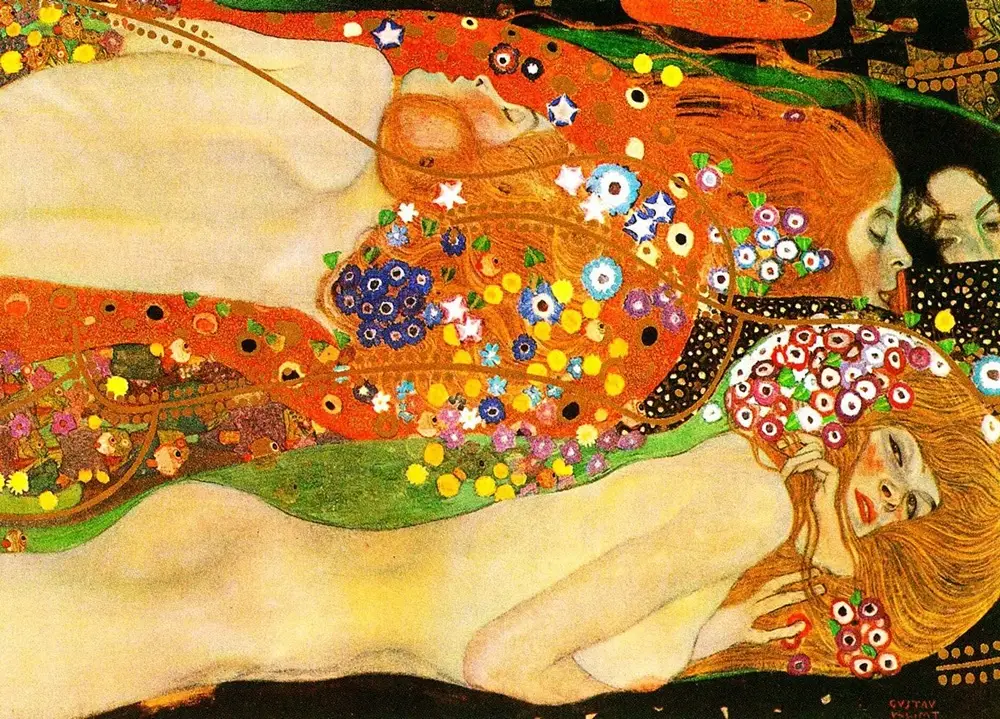
Introduction
“Watersnakes II” is a renowned painting created by the Austrian symbolist painter Gustav Klimt. It is a part of his series inspired by the motif of water serpents. Klimt, known for his distinctive style and use of symbolism, crafted this masterpiece during his “Golden Phase,” where he extensively employed gold leaf in his works.
Description
“Watersnakes II” depicts a mesmerizing scene of two entwined female figures, symbolizing water serpents, amidst a backdrop of swirling patterns and vibrant colors. The intertwining forms and intricate details evoke a sense of mystery and sensuality, characteristic of Klimt’s oeuvre. The figures seem to float in an otherworldly realm, surrounded by a shimmering aura of golden hues.
Technique
Klimt’s technique in “Watersnakes II” exemplifies his mastery of decorative art and symbolism. He employed a combination of oil paint and gold leaf, meticulously layering colors and textures to achieve a mesmerizing effect. The use of gold leaf adds a luminous quality to the painting, enhancing its ethereal atmosphere and imbuing it with a sense of opulence.
Price
As one of Klimt’s iconic works, “Watersnakes II” commands a high price in the art market. Due to its historical significance and artistic merit, it is highly sought after by collectors and art enthusiasts alike. However, specific pricing information can vary depending on factors such as the painting’s condition, provenance, and the venue of sale.
Painter
Gustav Klimt (1862–1918) was an influential Austrian symbolist painter and one of the foremost figures of the Vienna Secession movement. Known for his innovative style, rich symbolism, and lavish use of gold leaf, Klimt created a diverse body of work that continues to captivate audiences worldwide.
Location
“Watersnakes II” is housed in the collection of a renowned art institution or a private collector, depending on its current ownership status. While the exact location may vary, it is often displayed in museums or galleries that specialize in modern and contemporary art.
Accessibility
Access to view “Watersnakes II” may vary depending on its current location and ownership. If it is held in a public institution such as a museum or gallery, it may be accessible to the general public during regular visiting hours. However, if it is part of a private collection, access may be limited to special exhibitions or by appointment only.
Conclusion
“Watersnakes II” stands as a testament to Gustav Klimt’s artistic genius and his ability to evoke profound emotions through his mesmerizing compositions. With its captivating imagery, rich symbolism, and meticulous craftsmanship, it continues to enthrall audiences and remains a cherished masterpiece in the realm of art history.
In the contest of 25 Most Expensive Paintings in the World, Water Serpents II by Gustav Klimt claims the 9th position.
Pendant Portraits of Maerten Soolmans and Oopjen Coppit by Rembrandt
Price is approx. $180 Million on 2009
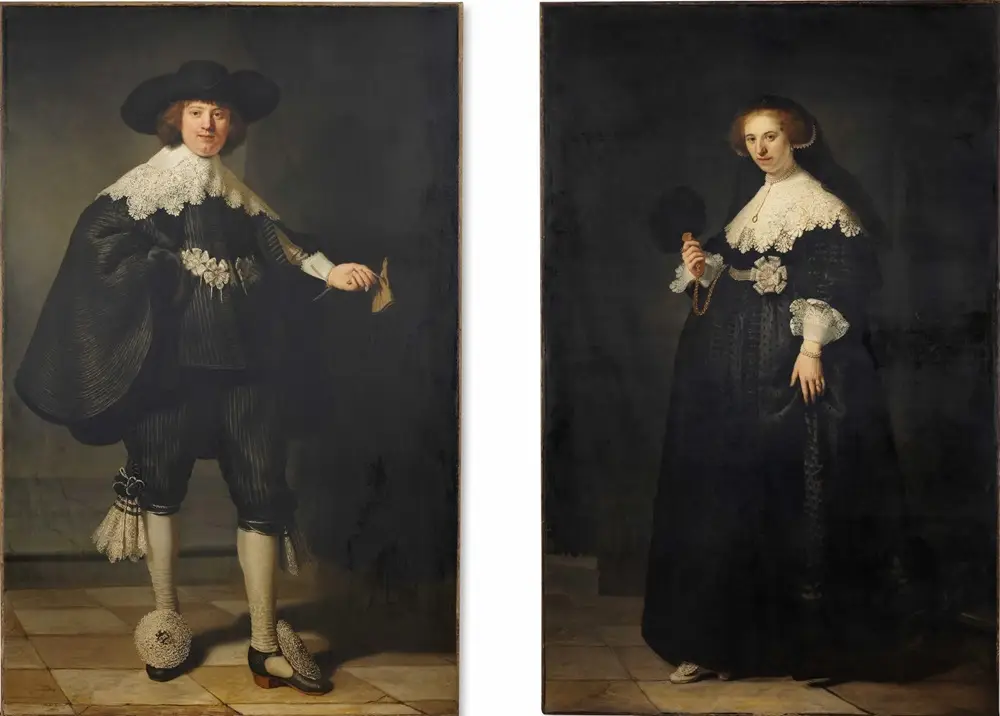
Introduction
Rembrandt van Rijn, a master of portraiture, created timeless works that capture the essence of his subjects with remarkable detail and depth. Among his notable pieces are the pendant portraits of Maerten Soolmans and Oopjen Coppit, exquisite examples of his craftsmanship and artistic vision. These portraits not only showcase Rembrandt’s technical prowess but also offer insights into the lives of the affluent individuals of his time.
Description
The pendant portraits of Maerten Soolmans and Oopjen Coppit are full-length depictions, showcasing the subjects standing in elegant attire against a dark background. Rembrandt’s mastery of light and shadow is evident in the way he illuminates their figures, lending a sense of depth and presence to the paintings. Maerten Soolmans is depicted wearing a luxurious black outfit with a lace collar, while Oopjen Coppit exudes grace and sophistication in her richly adorned gown. Both portraits exude a sense of nobility and opulence, characteristic of the Dutch Golden Age.
Technique
Rembrandt employed his signature chiaroscuro technique, utilizing contrasts between light and shadow to create depth and drama in the portraits. The meticulous attention to detail in capturing the textures of fabric and the expressions of the subjects demonstrates Rembrandt’s technical virtuosity. Each brushstroke is deliberate, contributing to the overall richness and realism of the portraits.
Price
The pendant portraits of Maerten Soolmans and Oopjen Coppit are priceless treasures, reflecting both their historical significance and artistic merit. In 2015, the Dutch and French governments jointly acquired the portraits for a staggering sum of €160 million, ensuring that they remain in the public domain for future generations to admire and appreciate.
Painter
Rembrandt van Rijn, one of the most celebrated painters of the Dutch Golden Age, is the mastermind behind these exquisite portraits. His profound understanding of human emotion and his ability to capture the essence of his subjects set him apart as a true genius of his craft.
Location
The pendant portraits of Maerten Soolmans and Oopjen Coppit are currently housed in the Rijksmuseum in Amsterdam, Netherlands. Here, visitors can marvel at these iconic works up close, immersing themselves in the beauty and grandeur of Rembrandt’s artistry.
Accessibility
The Rijksmuseum is easily accessible to visitors from around the world, welcoming art enthusiasts and scholars alike to explore its extensive collection. With modern facilities and accommodations for visitors with disabilities, the museum strives to make art accessible to everyone, ensuring that the pendant portraits of Maerten Soolmans and Oopjen Coppit can be enjoyed by all.
Conclusion
The pendant portraits of Maerten Soolmans and Oopjen Coppit stand as enduring testaments to Rembrandt’s unparalleled talent and the cultural richness of the Dutch Golden Age. Through his masterful use of technique and his ability to capture the essence of his subjects, Rembrandt has immortalized these individuals, allowing us to glimpse into their world centuries later.
As they continue to captivate audiences at the Rijksmuseum, these portraits serve as reminders of the timeless allure of art and the profound impact it can have on those who behold it. In the contest of 25 Most Expensive Paintings in the World, Pendant Portraits of Maerten Soolmans and Oopjen Coppit by Rembrandt claims the 10th position.
Les Femmes d’Alger (Version O) by Pablo Picasso
Price is approx. $179 Million on 2015
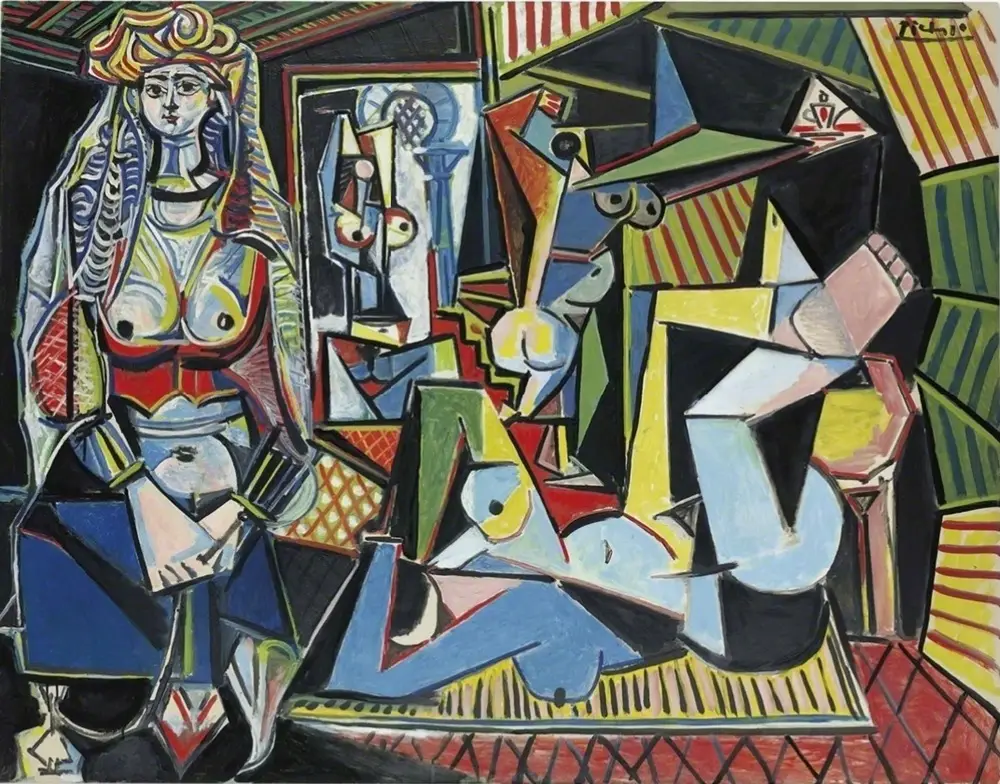
Introduction
Pablo Picasso’s “Les Femmes d’Alger (Version O)” is a masterpiece that stands as a testament to his unparalleled artistic genius. Created in 1955 as part of his series inspired by Delacroix’s “The Women of Algiers,” this painting represents a culmination of Picasso’s exploration of Cubism and abstraction.
Description
“Les Femmes d’Alger (Version O)” portrays a vibrant and intricate scene featuring several abstracted female figures lounging in a luxurious interior space. Picasso’s bold use of color and geometric shapes creates a dynamic composition that captivates the viewer’s attention. The figures are rendered with fragmented forms, showcasing Picasso’s mastery of Cubist techniques. Each element of the painting seems to intersect and overlap, blurring the boundaries between the figures and their surroundings.
Technique
Picasso’s innovative approach to painting is evident in “Les Femmes d’Alger (Version O).” Through his unique blend of Cubism and abstraction, he deconstructs and reinterprets traditional artistic conventions. The painting reflects Picasso’s ability to convey complex emotions and ideas through non-representational forms and colors. His use of bold brushstrokes and contrasting hues adds depth and texture to the composition, inviting viewers to engage with the work on multiple levels.
Price
“Les Femmes d’Alger (Version O)” is considered one of Picasso’s most iconic works and commands a significant price on the art market. In 2015, another version of the painting, “Les Femmes d’Alger (Version O)” from 1955, sold at auction for a record-breaking $179.4 million, making it one of the most expensive paintings ever sold.
Painter
Pablo Picasso, one of the most influential artists of the 20th century, was a Spanish painter, sculptor, and printmaker. His innovative artistic style and prolific body of work revolutionized the world of art and continue to inspire artists and audiences alike.
Location
“Les Femmes d’Alger (Version O)” is housed in a private collection and is not publicly accessible. However, reproductions and images of the painting can be found in art books, museums, and online galleries, allowing viewers to experience its beauty and significance.
Accessibility
While the original painting may not be accessible to the public, Picasso’s work remains widely accessible through various means, including exhibitions, publications, and digital platforms. Art enthusiasts can explore reproductions and interpretations of “Les Femmes d’Alger (Version O)” to gain a deeper understanding of Picasso’s artistic vision and legacy.
Conclusion
“Les Femmes d’Alger (Version O)” stands as a timeless masterpiece that continues to captivate audiences with its bold imagery and innovative approach to painting. Through this work, Picasso demonstrates his unparalleled creativity and mastery of artistic techniques, leaving a lasting impact on the world of art.
As one of the most celebrated paintings of the 20th century, “Les Femmes d’Alger (Version O)” serves as a testament to Picasso’s enduring legacy and his ability to push the boundaries of artistic expression. In the contest of 25 Most Expensive Paintings in the World, Les Femmes d’Alger (Version O) by Pablo Picasso claims the 11th position.
The Standard Bearer by Rembrandt
Price is approx. $175 Million on 2022

Introduction
“The Standard Bearer” is one of Rembrandt van Rijn’s lesser-known yet profoundly captivating artworks. Painted during the Dutch Golden Age, it stands as a testament to Rembrandt’s mastery of light, emotion, and narrative. This painting, though not as celebrated as some of his other works, holds a unique allure for art enthusiasts and historians alike.
Description
In “The Standard Bearer,” Rembrandt captures a moment of quiet intensity. The central figure, the standard bearer, stands tall amidst a scene of implied action. His gaze is steady, his expression resolute, as he holds the standard with a sense of purpose. The background is shrouded in darkness, emphasizing the prominence of the figure and adding a sense of mystery to the narrative. Rembrandt’s use of chiaroscuro, or the interplay of light and shadow, enhances the drama of the scene, casting the figure in a striking contrast that highlights his strength and determination.
Technique
Rembrandt’s technique in “The Standard Bearer” showcases his unparalleled skill in capturing the nuances of human emotion and character. His precise brushwork and subtle use of color create a sense of depth and realism, drawing the viewer into the scene. The meticulous attention to detail, particularly in the rendering of the figure’s face and attire, demonstrates Rembrandt’s dedication to his craft and his ability to imbue his subjects with a sense of life and vitality.
Price
As with many works of art by renowned masters like Rembrandt, the price of “The Standard Bearer” can vary significantly depending on factors such as provenance, condition, and market demand. Given its historical significance and artistic merit, it is likely to command a high price at auction or in private sales.
Painter
Rembrandt van Rijn (1606-1669) was a Dutch painter and one of the most influential artists of the Dutch Golden Age. Renowned for his mastery of light and shadow, as well as his profound understanding of human emotion, Rembrandt’s work continues to inspire and captivate audiences around the world.
Location
“The Standard Bearer” is housed in the collection of Cleveland Museum of Art, where it serves as a cherished highlight among their holdings of Dutch Golden Age art.
Accessibility
The accessibility of “The Standard Bearer” depends on the policies of the institution where it is housed. Many museums and galleries offer public access to their collections, allowing visitors to view and appreciate works of art like Rembrandt’s “The Standard Bearer” in person.
Conclusion
“The Standard Bearer” stands as a testament to Rembrandt’s genius and his ability to capture the human experience with unparalleled depth and insight. Through his mastery of technique and his profound understanding of light and emotion, Rembrandt invites viewers into a world of quiet contemplation and unspoken drama.
As a treasured masterpiece of the Dutch Golden Age, “The Standard Bearer” continues to captivate audiences with its timeless beauty and profound resonance. In the contest of 25 Most Expensive Paintings in the World, The Standard Bearer by Rembrandt claims the 12th position.
Masterpiece by Roy Lichtenstein
Price is approx. $165 Million on 2017
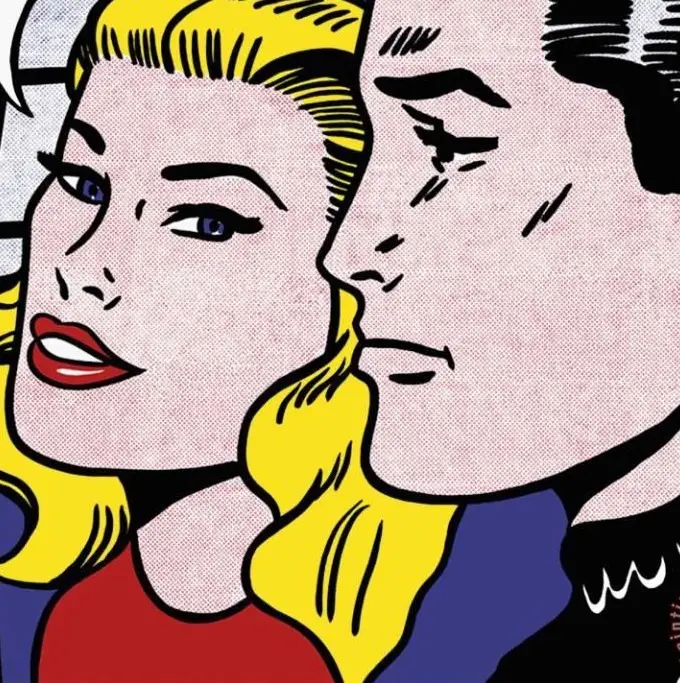
Introduction
“Masterpiece” is a renowned artwork by Roy Lichtenstein, one of the foremost figures in the pop art movement of the 1960s. This iconic piece epitomizes Lichtenstein’s distinctive style, characterized by its use of bold colors, comic book-inspired imagery, and Ben-Day dots. “Masterpiece” stands as a testament to Lichtenstein’s ability to elevate mundane subject matter into high art, challenging conventional notions of artistic value and representation.
Description
“Masterpiece” depicts a scene from a comic book, portraying a perplexed artist standing in front of his easel, looking at his work in progress. The composition is rendered in Lichtenstein’s signature style, featuring thick black outlines, vibrant primary colors, and meticulously applied dots to mimic the printing process of comic books. The use of text bubbles adds a dynamic element to the piece, inviting viewers to imagine the dialogue between the characters.
Technique
Lichtenstein employed a technique known as “comic book appropriation” to create “Masterpiece.” He meticulously replicated the aesthetic of comic book illustrations, utilizing precise lines and dots to emulate the mechanical printing process. This technique involved a careful balance between meticulous planning and spontaneous execution, highlighting Lichtenstein’s mastery of both technical skill and artistic innovation.
Price
As one of Lichtenstein’s most iconic works, “Masterpiece” commands a significant price on the art market. Recent auctions have seen the piece sell for millions of dollars, reflecting its status as a cornerstone of pop art history and a coveted collector’s item.
Painter
Roy Lichtenstein (1923–1997) was an American pop artist renowned for his pioneering work in the 1960s. Born in New York City, Lichtenstein rose to prominence for his distinctive reinterpretations of popular culture imagery, including comic strips, advertisements, and everyday objects. Throughout his career, he challenged traditional notions of high and low art, leaving an indelible mark on the art world with his bold, visually striking creations.
Location
“Masterpiece” is housed in various prestigious art institutions and private collections around the world. Its frequent appearances in major exhibitions and retrospectives attest to its significance within the canon of contemporary art. While its primary location may vary depending on loans and exhibitions, “Masterpiece” remains accessible to art enthusiasts through traveling exhibitions and digital reproductions.
Accessibility
Although “Masterpiece” may not always be on public display due to its value and demand, reproductions and digital representations ensure its accessibility to a wider audience. Museums often feature Lichtenstein’s work in their permanent collections or special exhibitions, providing opportunities for viewers to experience “Masterpiece” firsthand.Additionally, online galleries and virtual tours offer convenient ways for enthusiasts to engage with the artwork from anywhere in the world.
Conclusion
“Masterpiece” by Roy Lichtenstein stands as a quintessential example of pop art’s enduring influence on contemporary culture. Through its bold imagery, meticulous technique, and playful reinterpretation of visual language, the artwork invites viewers to reconsider the boundaries between high and low art.
As a timeless symbol of artistic innovation and cultural commentary, “Masterpiece” continues to captivate audiences and inspire dialogue about the nature of creativity and representation in the modern age. In the contest of 25 Most Expensive Paintings in the World, Masterpiece by Roy Lichtenstein claims the 13th position.
Nu Couché (Reclining Nude) by Amedeo Modigliani
Price is approx. $157 Million on 2018
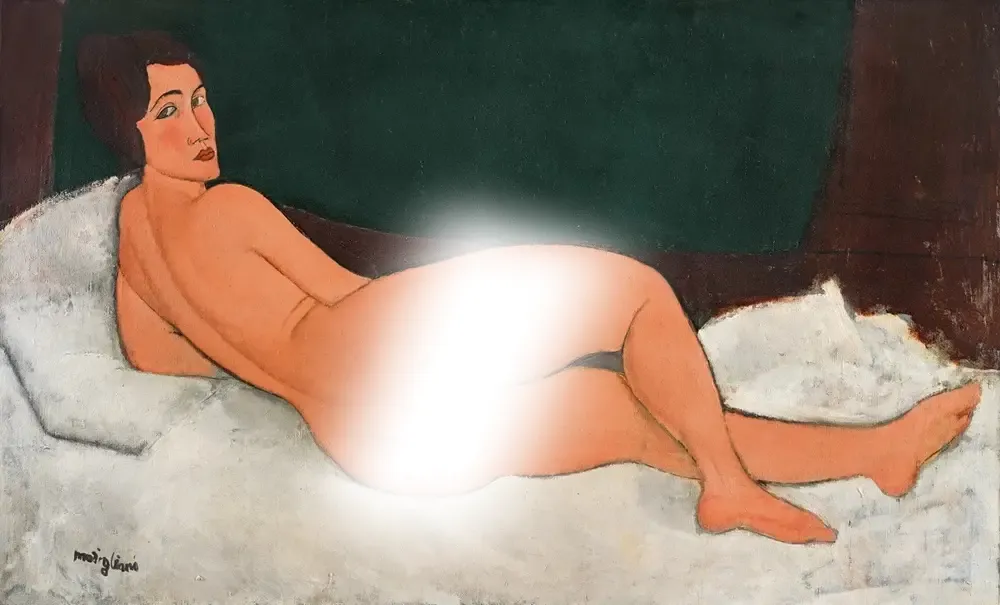
Introduction
Nu couché (Reclining Nude) by Amedeo Modigliani stands as one of the most iconic and controversial pieces in the realm of modern art. Painted in 1917, it encapsulates Modigliani’s distinctive style and serves as a testament to his fascination with the human form. This masterpiece has sparked discussions, both for its aesthetic allure and its historical significance within the art world.
Description
Nu couché depicts a reclining nude woman against a vibrant red background. Modigliani’s signature elongated figures are evident in the portrayal of the woman’s form, with graceful curves and elongated limbs. The subject’s face, with closed eyes and serene expression, adds a sense of tranquility to the composition. Modigliani’s use of color is minimal but impactful, with subtle variations of skin tones against the bold backdrop, creating a striking contrast.
Technique
Modigliani’s technique in Nu couché exemplifies his unique approach to portraiture. He utilized fluid brushstrokes and a simplified form to capture the essence of his subjects. The elongation of the figure and the stylized features evoke a sense of elegance and sensuality. The artist’s deliberate choice of colors and composition adds to the overall emotive quality of the piece, inviting viewers to contemplate the beauty of the human body.
Price
Nu couché has fetched significant sums at auction, with one version selling for over $170 million in 2015, making it one of the most expensive paintings ever sold. The value of the artwork reflects both its artistic merit and its historical importance within the context of modern art.
Painter
Amedeo Modigliani, an Italian painter and sculptor, is renowned for his distinctive style characterized by elongated figures and simplified forms. He was a prominent figure in the early 20th-century art scene in Paris, known for his bohemian lifestyle and artistic innovation. Modigliani’s works continue to captivate audiences worldwide, cementing his legacy as one of the great masters of modern art.
Location
Nu couché is housed in various museums and private collections around the world. While some versions are publicly accessible in renowned institutions such as the Metropolitan Museum of Art in New York and the Tate Modern in London, others remain in private hands, occasionally exhibited in galleries or loaned for special exhibitions.
Accessibility
Access to Nu couché may vary depending on its current location. Museums and galleries often feature the artwork as part of their permanent collections or special exhibitions, providing opportunities for the public to appreciate its beauty firsthand. Additionally, reproductions and images of the painting are widely available in art books and online platforms, ensuring its accessibility to a global audience.
Conclusion
Nu couché (Reclining Nude) by Amedeo Modigliani transcends its status as a mere painting, serving as a symbol of artistic innovation and cultural significance. Its timeless beauty and emotive power continue to resonate with viewers, inviting contemplation and admiration.
As a masterpiece of modern art, Nu couché stands as a testament to Modigliani’s genius and enduring legacy in the annals of art history. In the contest of 25 Most Expensive Paintings in the World, Nu Couché by Amedeo Modigliani claims the 14th position.
Le Rêve by Pablo Picasso
Price is approx. $155 Million on 2013
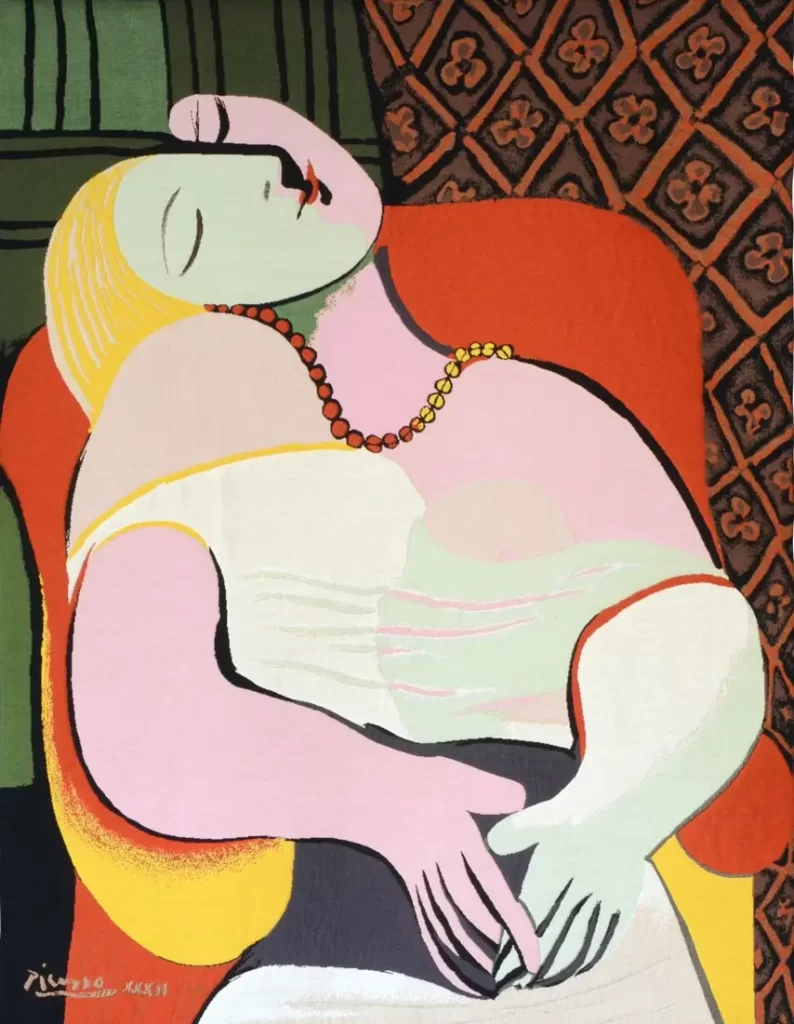
Introduction
Pablo Picasso, one of the most celebrated artists of the 20th century, created numerous masterpieces that have left an indelible mark on the world of art. Among these, “Le Rêve,” or “The Dream,” stands out as a quintessential example of Picasso’s unparalleled creativity and revolutionary style. This iconic painting embodies the essence of surrealism, captivating viewers with its enigmatic imagery and profound symbolism.
Description
“Le Rêve” depicts a reclining nude woman in a dreamlike state. The woman’s features are distorted and fragmented, characteristic of Picasso’s Cubist period. Her body is composed of geometric shapes and abstract forms, challenging conventional notions of beauty and representation. Despite the fragmented appearance, there is a sense of harmony and fluidity in the composition, as the various elements coalesce to form a unified whole. The colors are rich and vibrant, adding to the painting’s visual impact and emotional depth.
Technique
Picasso employed a variety of techniques in creating “Le Rêve,” including Cubism, a movement he co-founded. Cubism sought to depict objects from multiple perspectives simultaneously, breaking them down into geometric shapes and rearranging them in unconventional ways. In “Le Rêve,” Picasso applied these principles to the human form, transforming it into a complex interplay of lines, angles, and planes.
Price
“Le Rêve” is regarded as one of Picasso’s most valuable works, fetching a staggering price of $155 million in a private sale in 2013. This record-breaking sale underscored the painting’s significance and enduring appeal among collectors and art enthusiasts alike.
Painter
Pablo Picasso, a Spanish artist who lived from 1881 to 1973, was a towering figure in the world of modern art. Renowned for his prolific output and groundbreaking innovations, Picasso’s influence continues to reverberate through contemporary art.
Location
“Le Rêve” is currently housed in a private collection, inaccessible to the general public. However, it has been exhibited in museums and galleries around the world, allowing audiences to experience its power and beauty firsthand.
Accessibility
While “Le Rêve” may not be readily accessible to the public, reproductions and images of the painting can be found in books, online galleries, and museum collections. These provide opportunities for people to study and appreciate Picasso’s masterpiece, albeit in a different context.
Conclusion
“Le Rêve” exemplifies Pablo Picasso’s unparalleled artistic vision and mastery of form. Through its innovative composition, bold imagery, and profound symbolism, the painting invites viewers into a world of dreams and imagination.
Despite its hefty price tag and limited accessibility, “Le Rêve” continues to inspire awe and admiration, cementing its status as a timeless masterpiece of 20th-century art. In the contest of 25 Most Expensive Paintings in the World, Le Rêve by Pablo Picasso claims the 15th position.
Portrait of Adele Bloch-Bauer II by Gustav Klimt
Price is approx. $150 Million on 2016
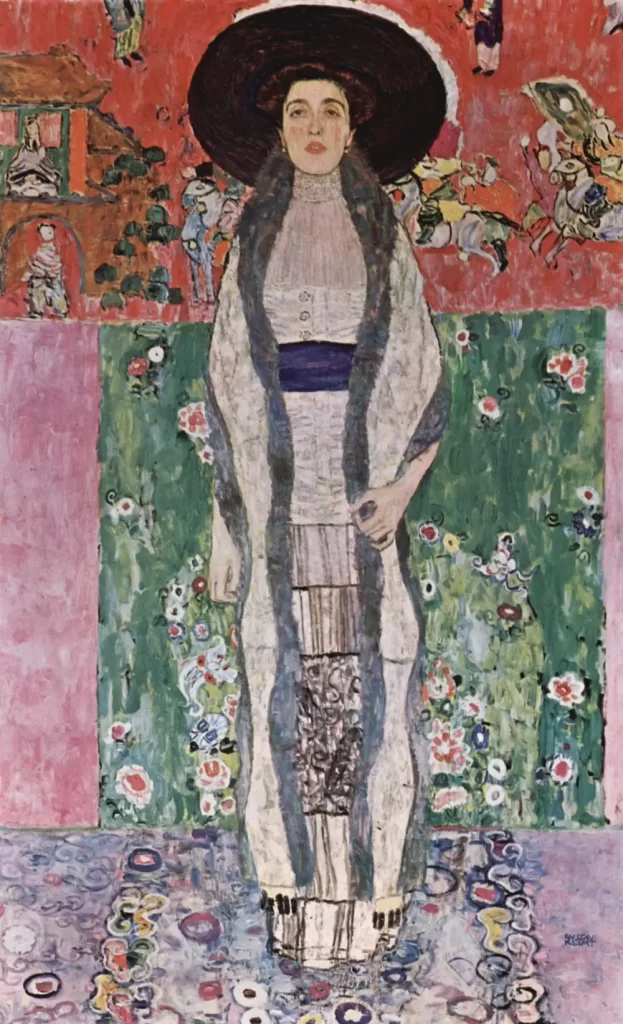
Introduction
Gustav Klimt, an Austrian symbolist painter, crafted masterpieces that transcended mere representation, delving into realms of symbolism, eroticism, and opulence. Among his renowned works stands the “Portrait of Adele Bloch-Bauer II,” a testament to Klimt’s mastery and the epitome of Viennese Art Nouveau.
Description
The “Portrait of Adele Bloch-Bauer II” portrays Adele Bloch-Bauer, the wife of a prominent Viennese industrialist. Set against a backdrop of intricate patterns and shimmering gold, Adele gazes serenely, her presence exuding elegance and refinement. Klimt’s use of rich colors and lavish ornamentation creates a sense of luxury, reflecting the opulent society of Vienna during the early 20th century.
Technique
Klimt’s technique in this portrait showcases his distinctive style, characterized by flattened forms, decorative motifs, and a harmonious blend of symbolism and realism. The intricate patterns adorning Adele’s gown and the shimmering gold leaf highlights demonstrate Klimt’s meticulous attention to detail and his mastery of decorative arts.
Price
In 2006, the “Portrait of Adele Bloch-Bauer II” made headlines when it was sold at auction for a staggering $87.9 million, making it one of the most expensive paintings ever sold at the time. This extraordinary price reflects not only the artistic significance of the piece but also its historical and cultural value.
Painter
Gustav Klimt, born in 1862 in Austria, was a pioneering figure in the Vienna Secession movement. His works, characterized by their bold use of color, intricate patterns, and symbolic motifs, had a profound influence on the development of modern art. Klimt’s legacy continues to inspire artists and art enthusiasts worldwide.
Location
The “Portrait of Adele Bloch-Bauer II” is currently housed in the Neue Galerie in New York City. This esteemed museum specializes in German and Austrian art from the early 20th century, making it a fitting home for Klimt’s masterpiece. The museum provides a serene and intimate setting for visitors to experience the beauty and brilliance of this iconic painting.
Accessibility
The Neue Galerie offers accessibility programs and accommodations to ensure that all visitors can enjoy its collection. This includes wheelchair access, audio guides, and descriptive materials for visually impaired visitors. Additionally, the museum provides online resources and virtual tours, allowing individuals from around the world to appreciate Klimt’s work.
Conclusion
The “Portrait of Adele Bloch-Bauer II” stands as a timeless symbol of beauty, wealth, and cultural heritage. Through Klimt’s visionary artistry, Adele Bloch-Bauer is immortalized in a masterpiece that transcends time and space, inviting viewers into a world of elegance and intrigue.
As it continues to captivate audiences around the globe, this iconic painting remains a testament to Gustav Klimt’s enduring legacy and the enduring power of art to inspire, enchant, and provoke contemplation. In the contest of 25 Most Expensive Paintings in the World, Portrait of Adele Bloch-Bauer II by Gustav Klimt claims the 16th position.
Three Studies of Lucian Freud by Francis Bacon
Price is approx. $142 Million on 2013

Introduction
“Three Studies of Lucian Freud” is a renowned triptych painted by the British artist Francis Bacon between 1969 and 1970. This masterpiece holds significant cultural and artistic value, representing Bacon’s distinctive style and his complex relationship with the subject, Lucian Freud, a fellow artist and close friend.
Description
The triptych features three separate panels, each portraying Lucian Freud seated on a chair. Bacon’s portrayal is characterized by his signature distorted and expressive style, with Freud’s figure contorted and almost grotesque in appearance. The use of bold colors, thick brushstrokes, and swirling forms creates a sense of emotional intensity and psychological depth within the artwork. Bacon’s interpretation of Freud captures not only physical likeness but also delves into the inner turmoil and complexity of the human psyche.
Technique
Francis Bacon employed his unique technique of painting, which involved the application of paint in thick layers using broad brushstrokes and the manipulation of forms to convey a sense of movement and emotion. Bacon’s unconventional approach to portraiture defied traditional norms, pushing the boundaries of figurative art and challenging viewers to confront the rawness and vulnerability of the human condition.
Price
“Three Studies of Lucian Freud” is considered one of Bacon’s most important works and has fetched record prices at auctions. In 2013, the triptych was sold for a staggering $142.4 million, setting a new world record for the most expensive artwork ever sold at auction at that time. The exorbitant price reflects the painting’s significance within the art world and its enduring appeal to collectors and connoisseurs alike.
Painter
Francis Bacon, born in 1909 in Dublin, Ireland, was a seminal figure in 20th-century art. Known for his bold and provocative paintings, Bacon is celebrated for his exploration of existential themes, human frailty, and the darker aspects of the human psyche. His distinctive style and uncompromising vision have cemented his legacy as one of the most influential artists of his generation.
Location
“Three Studies of Lucian Freud” is currently housed in various private and public collections around the world. It has been exhibited in prestigious museums and galleries, allowing audiences to experience Bacon’s powerful imagery firsthand. While the exact location may vary depending on loan agreements and exhibition schedules, the triptych remains an iconic fixture in the art world.
Accessibility
Access to view “Three Studies of Lucian Freud” may vary depending on its current location and exhibition status. However, reproductions and images of the triptych are widely available in art books, online databases, and digital archives, ensuring that its impact and significance are accessible to a global audience.
Conclusion
“Three Studies of Lucian Freud” stands as a testament to Francis Bacon’s artistic genius and his ability to capture the complexities of the human condition through paint and canvas. Its boldness, emotional intensity, and profound psychological depth continue to captivate viewers and inspire dialogue within the art world.
As a masterpiece of 20th-century art, the triptych remains a timeless symbol of Bacon’s enduring legacy and his relentless pursuit of truth and beauty in the realm of painting. In the contest of 25 Most Expensive Paintings in the World, Three Studies of Lucian Freud by Francis Bacon claims the 17th position.
Woman III by Willem De Kooning
Price is approx. $137 Million on 2006
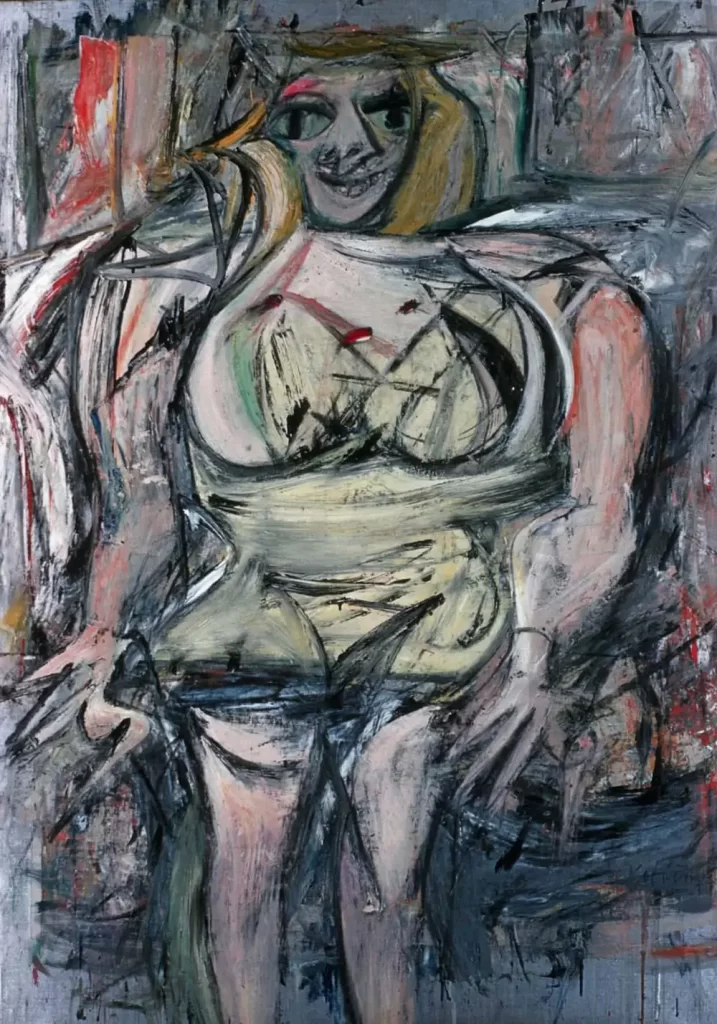
Introduction
In the realm of abstract expressionism, Willem de Kooning’s “Woman III” holds a significant place. This painting is a striking representation of the artist’s distinctive style, characterized by vigorous brushstrokes, vibrant colors, and a sense of emotional intensity. With its enigmatic portrayal of the female figure, “Woman III” invites viewers into a world of ambiguity and intrigue. “Woman III” is an iconic painting by Willem de Kooning, a renowned figure of the Abstract Expressionist movement. Created in 1953, this masterpiece stands as a testament to de Kooning’s bold experimentation with form, color, and emotion.
Description
“Woman III” depicts a towering female figure that dominates the canvas with its dynamic presence. The woman’s contorted form seems to pulsate with energy, her features both exaggerated and abstracted. De Kooning’s frenetic brushwork creates a sense of movement and depth, as if the figure is constantly in flux. The colors—bold strokes of red, yellow, blue, and green—contribute to the painting’s visceral impact, evoking a range of emotions from passion to unease.
Technique
De Kooning’s technique in “Woman III” is characterized by his spontaneous and gestural approach to painting. He often worked in a state of frenzied creativity, allowing his emotions to guide his brush across the canvas. This uninhibited method resulted in dynamic compositions filled with raw energy and emotion. De Kooning also employed a process of layering, adding and subtracting paint to achieve the desired effect, creating a sense of depth and complexity in his work.
Price
As one of de Kooning’s most celebrated works, “Woman III” holds immense value in the art market. While its exact price fluctuates based on factors such as condition, provenance, and market demand, it is undoubtedly a highly sought-after piece among collectors. In 2006, “Woman III” was sold by David Geffen to billionaire Steven A. Cohen for a reported $137.5 million, making it one of the most expensive paintings ever sold at the time.
Painter
Willem de Kooning, born in Rotterdam, Netherlands, in 1904, was a pioneering figure of the Abstract Expressionist movement. Alongside artists like Jackson Pollock and Mark Rothko, de Kooning helped shape the course of 20th-century art with his innovative approach to painting. His work often explored themes of the human figure, abstraction, and the subconscious, earning him international acclaim and recognition.
Location
“Woman III” is currently housed in the collection of billionaire hedge fund manager Steven A. Cohen. While the painting has been exhibited in various museums and galleries around the world, it remains a centerpiece of Cohen’s private collection.
Accessibility
As a privately-owned artwork, accessibility to “Woman III” is limited to the discretion of its owner, Steven A. Cohen. However, reproductions and images of the painting can be found in books, online resources, and museum publications, allowing art enthusiasts to experience its power and beauty vicariously.
Conclusion
“Woman III” stands as a testament to Willem de Kooning’s bold artistic vision and his enduring influence on the world of abstract expressionism. With its vibrant colors, dynamic composition, and enigmatic subject matter, this iconic painting continues to captivate viewers and inspire dialogue about the nature of art and creativity. In the contest of 25 Most Expensive Paintings in the World, Woman III by Willem De Kooning claims the 18th position.
Portrait of Adele Bloch-Bauer I by Gustav Klimt
Price is approx. $135 Million on 2006
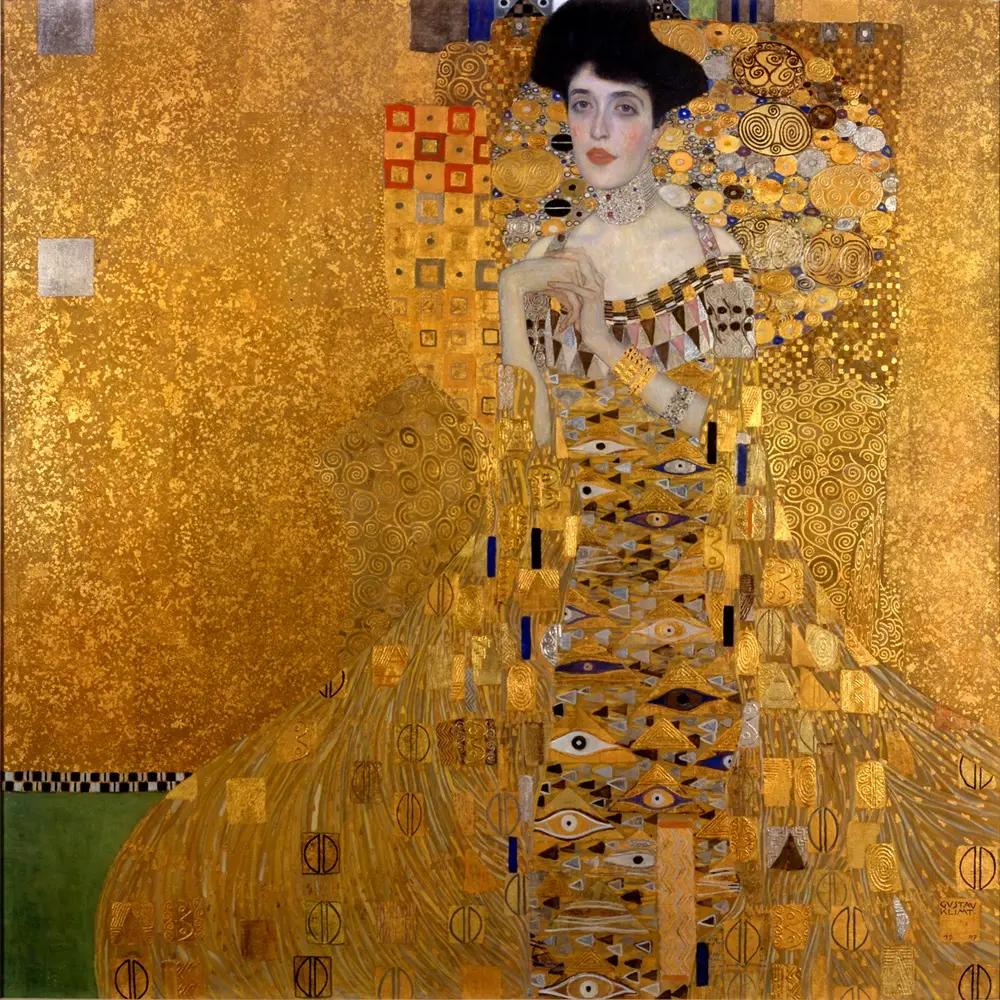
Introduction
Gustav Klimt’s “Portrait of Adele Bloch-Bauer I” is an iconic masterpiece that transcends time and space, captivating audiences with its ethereal beauty and intricate symbolism. Painted during the height of the Viennese Secession movement, this portrait stands as a testament to Klimt’s unparalleled talent and his ability to fuse symbolism with stunning aesthetics.
Description
The portrait depicts Adele Bloch-Bauer, a prominent Viennese socialite and patron of the arts, adorned in opulent robes and surrounded by a shimmering golden aura. Klimt’s use of gold leaf and intricate patterns creates a mesmerizing effect, drawing viewers into a world of luxury and refinement. Adele’s enigmatic expression hints at a complexity beneath her elegant facade, inviting interpretation and speculation.
Technique
Klimt’s technique in “Portrait of Adele Bloch-Bauer I” is characterized by his signature style, which blends elements of Symbolism and Art Nouveau. The painting features meticulous attention to detail, with each brushstroke contributing to the overall richness and texture of the piece. Klimt’s use of gold leaf adds a luminous quality to the portrait, elevating it to an otherworldly realm of beauty.
Price
In 2006, “Portrait of Adele Bloch-Bauer I” made headlines when it was sold at auction for a staggering $135 million, making it one of the most expensive paintings ever sold at the time. The high price tag reflects not only the painting’s intrinsic value as a work of art but also its cultural significance and historical importance.
Painter
Gustav Klimt, the mastermind behind “Portrait of Adele Bloch-Bauer I,” was a pioneering figure in the Viennese Secession movement. Renowned for his decorative style and avant-garde approach to art, Klimt’s work continues to inspire and influence artists around the world.
Location
The “Portrait of Adele Bloch-Bauer I” is housed in the Neue Galerie in New York City, where it serves as one of the museum’s most prized possessions. Its presence in the heart of Manhattan allows art enthusiasts and casual visitors alike to experience firsthand the beauty and brilliance of Klimt’s masterpiece.
Accessibility
The Neue Galerie is open to the public, offering visitors the opportunity to view “Portrait of Adele Bloch-Bauer I” alongside other notable works of German and Austrian art. The museum is wheelchair accessible and provides various accommodations to ensure that all visitors can enjoy its exhibitions.
Conclusion
In conclusion, Gustav Klimt’s “Portrait of Adele Bloch-Bauer I” stands as a timeless masterpiece that continues to captivate audiences with its beauty and symbolism. From its meticulous technique to its staggering price tag, this painting represents the pinnacle of Klimt’s artistic achievement and remains a cornerstone of the Neue Galerie’s collection.
As visitors gaze upon Adele’s enigmatic smile and shimmering robes, they are transported to a world of elegance and intrigue, where art transcends mere representation to become a window into the soul. In the contest of 25 Most Expensive Paintings in the World, Portrait of Adele Bloch-Bauer I by Gustav Klimt claims the 19th position.
Silver Car Crash (Double Disaster) by Andy Warhol
Price is approx. $105 Million on 2013
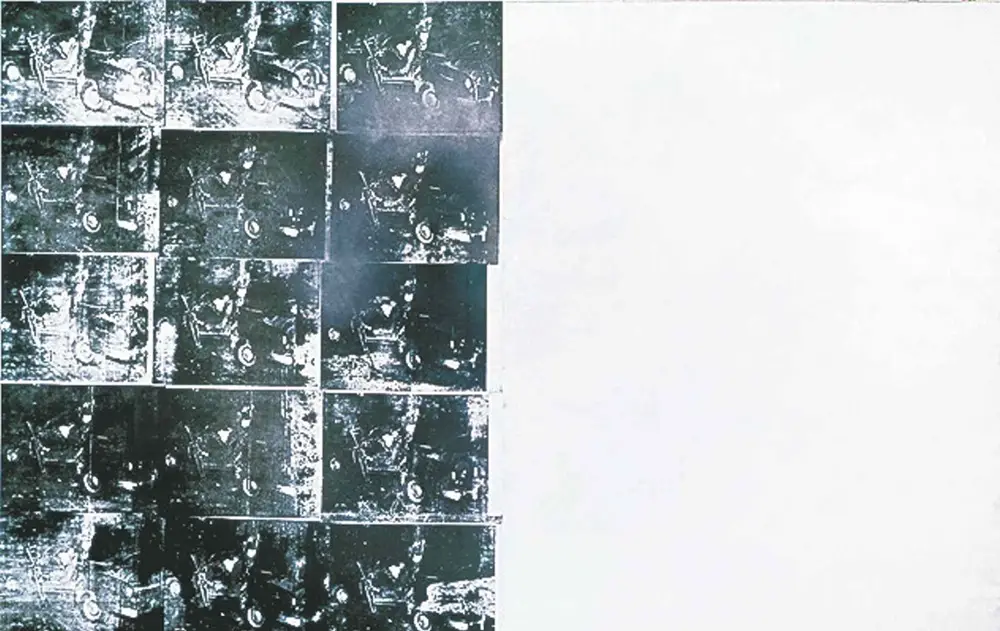
Introduction
Andy Warhol, a pioneering figure in the Pop Art movement, created Silver Car Crash (Double Disaster) in 1963. This iconic piece encapsulates Warhol’s fascination with the intersection of celebrity, consumer culture, and tragedy. Through his distinctive artistic lens, Warhol immortalizes a mundane yet profoundly impactful moment in history, transforming it into a powerful commentary on society.
Description
Silver Car Crash (Double Disaster) portrays the aftermath of a car accident, rendered in Warhol’s signature silkscreen technique. The image features a silver car mangled in a collision, surrounded by emergency responders and onlookers. Warhol’s use of repetitive imagery and bold colors amplifies the scene’s intensity, inviting viewers to confront the harsh realities of mortality and the fleeting nature of fame.
Technique
Warhol employed the silkscreen printing technique to create Silver Car Crash (Double Disaster). This method allowed him to replicate images with precision, blurring the lines between mass production and fine art. By appropriating images from mass media sources, Warhol challenged traditional notions of authorship and originality, pushing the boundaries of contemporary art.
Price
As one of Warhol’s most renowned works, Silver Car Crash (Double Disaster) holds significant value in the art market. Its price fluctuates depending on factors such as provenance, condition, and demand. In recent years, similar Warhol pieces have fetched millions of dollars at auction, attesting to the enduring allure of his oeuvre.
Painter
Andy Warhol, born Andrew Warhola in 1928, rose to prominence as a leading figure in the Pop Art movement during the 1960s. Renowned for his bold aesthetic and unconventional approach to art-making, Warhol challenged conventional notions of beauty and artistic expression. Through his diverse body of work, which encompassed painting, printmaking, sculpture, and film, Warhol left an indelible mark on the art world.
Location
Silver Car Crash (Double Disaster) is housed in various prestigious art institutions and private collections worldwide. While its primary location may vary, the piece continues to captivate audiences wherever it is displayed, inviting contemplation on themes of mortality, consumerism, and the media’s role in shaping collective consciousness.
Accessibility
Access to Silver Car Crash (Double Disaster) may vary depending on its current location. However, many institutions strive to make Warhol’s work accessible to the public through exhibitions, educational programs, and digital initiatives. Whether viewed in person or online, experiencing Warhol’s art offers a unique opportunity to engage with contemporary culture and explore the complexities of the human condition.
Conclusion
Silver Car Crash (Double Disaster) stands as a testament to Andy Warhol’s enduring legacy as an artist provocateur. Through his innovative techniques and bold subject matter, Warhol challenged conventions and reshaped the landscape of modern art.
As viewers confront the haunting imagery of Silver Car Crash (Double Disaster), they are reminded of the power of art to provoke thought, evoke emotion, and transcend the boundaries of time and space. In the contest of 25 Most Expensive Paintings in the World, Silver Car Crash (Double Disaster) by Andy Warhol claims the 20th position.
Portrait of Dr. Gachet by Vincent Van Gogh
Price is approx. $82 Million on 1990
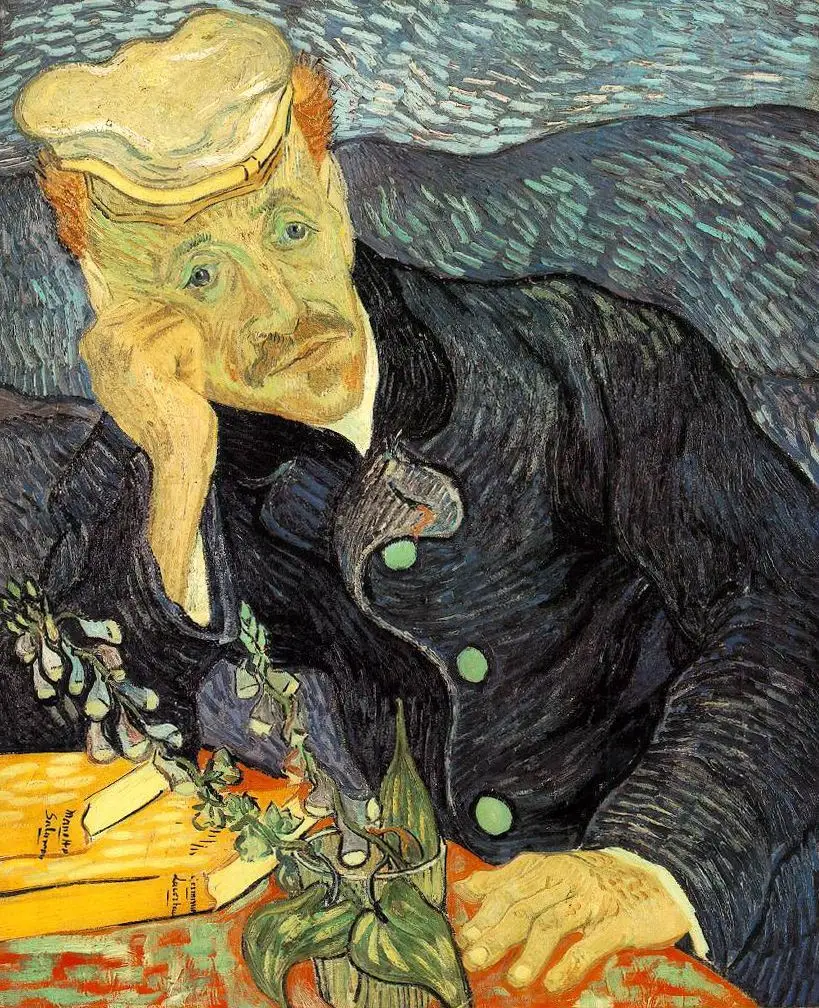
Introduction
Vincent van Gogh’s “Portrait of Dr. Gachet” stands as a poignant testament to the artist’s mastery and his turbulent inner world. Painted in 1890 during the last months of van Gogh’s life, this masterpiece encapsulates both the artist’s emotional turmoil and his deep connection with his subjects. From its evocative portrayal of Dr. Gachet to its striking use of color and brushwork, this painting continues to captivate audiences around the world.
Description
“Portrait of Dr. Gachet” depicts the physician Paul Gachet, who treated van Gogh during his time in Auvers-sur-Oise. The portrait is infused with a sense of melancholy, with Dr. Gachet’s weary expression hinting at the burdens of his profession and the artist’s troubled state of mind. Van Gogh employs bold, swirling brushstrokes to convey the intensity of his emotions, particularly in the expressive rendering of Gachet’s face and the vibrant background.
The use of complementary colors, such as the interplay between the rich blues and vivid greens, adds depth and dynamism to the composition. Van Gogh’s distinctive style, characterized by his thick application of paint and emotive brushwork, imbues the portrait with a raw, visceral energy that resonates with viewers.
Technique
Van Gogh employed his signature technique of impasto, applying paint in thick, textured layers to create a sense of depth and movement. His use of color was intuitive and expressive, with each brushstroke conveying a sense of emotion and intensity. The artist’s bold experimentation with form and composition further enhances the impact of the portrait, capturing the essence of his subject with remarkable vitality.
Price
“Portrait of Dr. Gachet” holds immense cultural and historical significance, making it one of the most sought-after works of art. While its exact value is difficult to ascertain due to its status as a priceless masterpiece, it has fetched record prices at auction, with one notable sale reaching well into the tens of millions.
Painter
Vincent van Gogh, the renowned Dutch Post-Impressionist painter, is celebrated for his groundbreaking contributions to the art world. His distinctive style and emotive approach to painting have left an indelible mark on the history of art, inspiring generations of artists and admirers alike.
Location
“Portrait of Dr. Gachet” is housed in various prestigious institutions and private collections around the world, ensuring its enduring legacy and accessibility to art enthusiasts globally.
Accessibility
While the original painting may be inaccessible to many due to its limited display and stringent security measures, replicas and high-quality reproductions allow a broader audience to experience van Gogh’s genius firsthand. Additionally, digital platforms and exhibitions provide virtual access to this iconic work of art, democratizing its appreciation and ensuring its relevance for future generations.
Conclusion
Vincent van Gogh’s “Portrait of Dr. Gachet” stands as a masterpiece of emotional intensity and artistic innovation. Through its evocative portrayal of the physician Paul Gachet, van Gogh invites viewers into his tumultuous inner world, capturing the essence of human experience with unparalleled depth and sincerity.
As a testament to the enduring power of art, this iconic painting continues to inspire and resonate with audiences worldwide, reaffirming van Gogh’s status as one of the greatest painters in history. In the contest of 25 Most Expensive Paintings in the World, Portrait of Dr. Gachet by Vincent Van Gogh claims the 21st position.
Water Lily Pond by Claude Monet
Price is approx. $80 Million on 2008

Introduction
“Water Lily Pond” is one of Claude Monet’s most iconic works, capturing the essence of his fascination with light, color, and nature. Created during his later years, this masterpiece exemplifies Monet’s mastery of the Impressionist style, depicting a serene scene of water lilies floating on a pond. In this essay, we’ll explore the significance of “Water Lily Pond” by delving into its description, technique, and the broader context of Monet’s artistic vision.
Description
“Water Lily Pond” is a large-scale oil painting that measures approximately 90 x 89 inches. Completed between 1899 and 1900, it features a tranquil pond adorned with vibrant water lilies in various shades of pink, violet, and white. The surface of the water reflects the surrounding foliage and sky, creating a mesmerizing interplay of colors and light. Monet’s loose brushwork and delicate handling of color imbue the scene with a sense of movement and atmosphere, evoking the fleeting nature of time and perception.
Technique
Monet’s technique in “Water Lily Pond” showcases his innovative approach to capturing the fleeting effects of light and atmosphere. He applied layers of thin, translucent paint using short, rhythmic brushstrokes, allowing the colors to blend optically and create a sense of depth and luminosity. By painting en plein air, or outdoors, Monet was able to observe and capture the subtle nuances of light and shadow directly from nature, infusing his work with a sense of immediacy and spontaneity.
Price
As one of Monet’s most celebrated works, “Water Lily Pond” holds immense value both artistically and monetarily. While its exact price fluctuates depending on factors such as provenance and condition, it is considered an invaluable treasure of art history. Works by Monet, especially those from his Water Lilies series, have fetched millions of dollars at auction, reflecting the enduring demand for his pioneering contributions to Impressionism.
Painter
Claude Monet (1840–1926) was a French painter and one of the leading figures of the Impressionist movement. Renowned for his innovative approach to capturing the fleeting effects of light and atmosphere, Monet’s work revolutionized the way artists perceive and represent the natural world. Throughout his prolific career, he painted numerous landscapes, seascapes, and garden scenes, earning acclaim for his bold use of color and expressive brushwork.
Location
“Water Lily Pond” is housed in the collection of the Musée d’Orsay in Paris, France. Situated on the Left Bank of the Seine River, the museum is renowned for its extensive collection of Impressionist and Post-Impressionist masterpieces, including works by Monet, Renoir, and Van Gogh. Visitors to the museum have the opportunity to experience firsthand the beauty and brilliance of “Water Lily Pond” within the context of its rich artistic heritage.
Accessibility
The Musée d’Orsay is easily accessible via public transportation, with nearby metro and RER stations providing convenient links to the rest of Paris. The museum is wheelchair accessible, ensuring that visitors of all abilities can enjoy its world-class collection. Additionally, the museum offers guided tours and educational programs for those interested in learning more about Monet’s life and artistic legacy.
Conclusion
“Water Lily Pond” stands as a testament to Claude Monet’s unparalleled talent and visionary approach to painting. Through his mastery of technique and keen observation of nature, Monet transformed the ordinary into the extraordinary, capturing the essence of beauty and tranquility in a single brushstroke.
As viewers gaze upon the luminous waters of “Water Lily Pond,” they are transported to a realm of timeless serenity, where art and nature converge in perfect harmony. In the contest of 25 Most Expensive Paintings in the World, Water Lily Pond by Claude Monet claims the 22nd position.
Bal Du Moulin De La Galette by Pierre-Auguste Renoir
Price is approx. $78 Million on 1990

Introduction
Pierre-Auguste Renoir’s “Bal du moulin de la Galette” stands as a masterpiece of Impressionist art, capturing the essence of Parisian life in the late 19th century. With its vibrant portrayal of a lively dance scene at the Moulin de la Galette, this painting continues to captivate audiences with its rich colors, dynamic composition, and evocative atmosphere.
Description
Painted in 1876, “Bal du moulin de la Galette” depicts a bustling Sunday afternoon at one of Montmartre’s most popular outdoor dance halls. Renoir masterfully portrays the joyous atmosphere as couples twirl and mingle amidst the dappled sunlight filtering through the trees. Figures are rendered with fluid brushstrokes, their movements seemingly caught in a moment of spontaneous celebration. The composition is lively yet carefully balanced, with a sense of depth that draws the viewer into the scene.
Technique
Renoir’s technique in “Bal du moulin de la Galette” exemplifies the principles of Impressionism. He employs loose, gestural brushwork to capture the fleeting effects of light and movement. The artist’s use of bold, contrasting colors creates a sense of vibrancy and vitality, while his emphasis on capturing the play of light lends the painting a luminous quality.
Price
As one of Renoir’s most celebrated works, “Bal du moulin de la Galette” holds significant value in the art market. While its exact price fluctuates depending on factors such as condition, provenance, and demand, notable sales of Renoir’s works in recent years suggest that “Bal du moulin de la Galette” could fetch tens of millions of dollars at auction.
Painter
Pierre-Auguste Renoir, a leading figure of the Impressionist movement, is renowned for his mastery of color, light, and form. Born in 1841 in Limoges, France, Renoir emerged as one of the most influential artists of his time, renowned for his ability to capture the fleeting beauty of everyday life with warmth and sensitivity.
Location
“Bal du moulin de la Galette” is housed in the Musée d’Orsay in Paris, where it continues to enchant visitors with its vibrant depiction of Belle Époque Paris. The museum’s collection features an extensive selection of Impressionist masterpieces, making it a must-visit destination for art enthusiasts from around the world.
Accessibility
The Musée d’Orsay is centrally located in Paris, making it easily accessible by public transportation. Visitors can enjoy convenient access to the museum’s extensive collection, including “Bal du moulin de la Galette,” as well as a range of amenities such as guided tours, educational programs, and dining options.
Conclusion
“Bal du moulin de la Galette” stands as a testament to Renoir’s artistic genius and the enduring allure of Impressionist painting. With its vibrant colors, dynamic composition, and evocative atmosphere, this masterpiece continues to captivate audiences and inspire admiration for the beauty of everyday life in 19th-century Paris.
Through its depiction of a joyous dance scene at the Moulin de la Galette, Renoir invites viewers to immerse themselves in a world of light, color, and celebration, ensuring its place as one of the most beloved works of art in the history of Western painting. In the contest of 25 Most Expensive Paintings in the World, Bal Du Moulin De La Galette by Pierre-Auguste Renoir claims the 23rd position.
Untitled XXV by Willem De Kooning
Price is approx. $66 Million on 2016

Introduction
“Untitled XXV” is a compelling artwork created by the renowned Dutch-American artist Willem de Kooning. This abstract expressionist masterpiece captivates viewers with its dynamic composition, vibrant colors, and expressive brushwork. Through this painting, de Kooning invites us into a world of spontaneity and emotion, where form and color intertwine to evoke a myriad of interpretations.
Description
“Untitled XXV” is a large-scale canvas that measures approximately 6 feet by 8 feet. Upon first glance, viewers are immediately drawn to the energetic interplay of shapes and colors that dominate the composition. Bold strokes of paint sweep across the canvas, creating a sense of movement and rhythm. Splashes of vibrant hues—reds, yellows, blues, and greens—dance against a backdrop of darker tones, imbuing the painting with a sense of depth and complexity. While abstract in nature, the work hints at organic forms and figures, inviting viewers to explore the depths of their imagination.
Technique
De Kooning’s technique in “Untitled XXV” showcases his mastery of gestural abstraction. He employed a combination of brushwork and palette knife to build layers of paint, creating texture and depth. The spontaneous and improvisational nature of his process is evident in the dynamic interplay of forms and colors. De Kooning’s bold use of color and gesture imbues the painting with a sense of vitality and dynamism, capturing the essence of the abstract expressionist movement.
Price
As one of de Kooning’s seminal works, “Untitled XXV” holds significant value in the art market. While exact prices for individual works can vary depending on factors such as provenance and condition, paintings by de Kooning have fetched millions of dollars at auction. “Untitled XXV” would likely command a substantial price, reflecting both its artistic importance and the demand for works by the artist.
Painter
Willem de Kooning (1904–1997) was a pioneering figure in the abstract expressionist movement. Born in Rotterdam, the Netherlands, de Kooning immigrated to the United States in 1926, where he would become one of the leading artists of his generation. Known for his bold experimentation with form and color, de Kooning’s work continues to influence artists and audiences alike.
Location
“Untitled XXV” is part of a private collection, its exact location may vary depending on the current owner’s preferences. However, it has been exhibited in major museums and galleries around the world, allowing audiences to experience its power and beauty firsthand.
Accessibility
As a privately owned artwork, accessibility to “Untitled XXV” may be limited to select exhibitions or viewings arranged by the owner. However, reproductions and images of the painting are widely available in books, online resources, and museum catalogs, allowing art enthusiasts to engage with the work on a broader scale.
Conclusion
“Untitled XXV” stands as a testament to Willem de Kooning’s innovative vision and artistic prowess. Its vibrant colors, dynamic composition, and expressive brushwork continue to captivate viewers, inviting them into a world of boundless creativity and emotion.
As a seminal work of abstract expressionism, “Untitled XXV” holds a significant place in art history, inspiring generations of artists and art lovers alike. In the contest of 25 Most Expensive Paintings in the World, Untitled XXV by Willem De Kooning claims the 24th position.
FAQ’s About Most Expensive Paintings in the World
Why Paintings Are So Expensive?
Paintings can be expensive for several reasons:
- Artist Recognition: Paintings by well-known artists or those with established reputations tend to command higher prices due to their status in the art world. The artist’s name, their influence on art movements, and their track record of sales can significantly impact the value of their work.
- Rarity and Demand: If a painting is rare or highly sought after by collectors, its price can skyrocket. Limited editions, unique styles, or paintings that are part of a famous series can all drive up demand and therefore price.
- Historical Significance: Paintings with historical significance, such as those depicting important events or cultural movements, often have higher value due to their role in preserving and reflecting history.
- Quality and Skill: The skill, technique, and craftsmanship involved in creating a painting can greatly influence its value. Paintings that demonstrate exceptional skill, attention to detail, and artistic innovation often command higher prices.
- Materials and Time: The cost of materials, as well as the time and effort invested by the artist, can contribute to the price of a painting. High-quality materials such as specialized paints, canvases, and brushes, along with the time-intensive nature of creating a masterpiece, can all contribute to higher costs.
- Gallery and Auction House Fees: Art galleries and auction houses typically take a percentage of the final sale price as commission. This markup can contribute to the overall cost of a painting.
- Market Trends and Speculation: Like any other commodity, the value of paintings can be influenced by market trends and speculation. If a particular artist or style becomes trendy or highly sought after, prices for associated works may increase accordingly.
- Investment Potential: Some buyers purchase paintings as investments, hoping that their value will appreciate over time. This speculative aspect can drive up prices, particularly for works by artists with a track record of increasing value.
Overall, the price of a painting is determined by a combination of factors including the artist’s reputation, the painting’s rarity and demand, its quality and craftsmanship, historical significance, and market dynamics.
Why Do People Buy Expensive Painting?
People buy expensive paintings for a variety of reasons, including:
- Investment: Some people see art as an investment opportunity. They may purchase expensive paintings with the expectation that their value will increase over time, allowing them to potentially sell them for a profit in the future.
- Status and Prestige: Owning expensive artwork can signal wealth, sophistication, and taste. For some individuals, displaying valuable paintings in their homes or offices enhances their social status and prestige among peers.
- Artistic Appreciation: Many buyers are genuinely passionate about art and appreciate the skill, creativity, and beauty behind expensive paintings. They derive pleasure from owning and experiencing works of art firsthand.
- Emotional Connection: Certain paintings hold personal significance or evoke strong emotions for buyers. They may feel a deep connection to the artist’s vision or the themes depicted in the artwork, prompting them to purchase it regardless of the cost.
- Decorative Purposes: Expensive paintings are often used as decorative pieces in homes, offices, and public spaces. Buyers may be drawn to a particular painting because they believe it will complement their interior design or enhance the ambiance of a room.
- Cultural and Historical Value: Some expensive paintings are considered cultural treasures or historically significant works of art. Collectors and institutions may acquire these pieces to preserve and promote cultural heritage for future generations.
- Collector’s Mentality: Art collectors may be driven by a passion for building and curating their collections. They enjoy the process of acquiring rare and valuable artworks, expanding their knowledge of art history, and sharing their collection with others.
- Philanthropy: Some individuals purchase expensive paintings as a form of philanthropy, supporting artists, galleries, museums, and cultural institutions. They may donate or lend their acquisitions to public exhibitions, contributing to the enrichment of cultural life in their communities.
Overall, the motivations for buying expensive paintings can vary widely, encompassing financial, social, aesthetic, emotional, and philanthropic considerations.
What Makes a Painting Look Expensive?
Several factors contribute to making a painting look expensive:
- Artist Recognition: Paintings by well-known, respected, or historically significant artists tend to command higher prices. The reputation and popularity of the artist play a significant role in determining the value of the artwork.
- Provenance: The history of ownership, or provenance, can greatly affect the perceived value of a painting. If a painting has a prestigious provenance, such as being owned by a famous collector or displayed in a renowned museum, its value may increase.
- Quality of Execution: The skill and technique demonstrated in the painting can greatly influence its value. Paintings that exhibit mastery of composition, color, perspective, and other artistic elements are often considered more valuable.
- Subject Matter: Paintings depicting desirable or culturally significant subjects may be more valuable than those depicting ordinary scenes or subjects. Historical events, famous figures, and landscapes of iconic locations can all contribute to a painting’s perceived value.
- Materials Used: The quality of materials used in creating the painting can affect its value. Paintings created with rare or expensive pigments, high-quality canvas, and archival-grade materials may be valued more highly.
- Size and Scale: Larger paintings often command higher prices due to the greater amount of materials and effort required to create them. Additionally, larger paintings can have a more significant visual impact, which may increase their perceived value.
- Condition and Preservation: The condition of the painting, including factors such as whether it has been well-preserved or restored, can influence its value. Paintings in excellent condition are typically more valuable than those that are damaged or poorly maintained.
- Market Demand: Ultimately, the perceived value of a painting is also influenced by market demand. If there is high demand for works by a particular artist or within a specific style or genre, prices may increase accordingly.
Overall, the perceived value of a painting is determined by a complex interplay of factors, including artistic merit, historical significance, market demand, and the subjective preferences of collectors and art enthusiasts.
Which Type of Painting is Most Expensive?
The value of a painting can vary greatly depending on various factors such as the artist, the period it was created, its condition, its provenance, and the demand for the artist’s work. Generally, paintings from renowned artists such as Leonardo da Vinci, Pablo Picasso, Vincent van Gogh, and Claude Monet tend to command the highest prices at auctions and in private sales.
Within the realm of art, certain genres or styles can also fetch higher prices due to their historical significance or cultural prominence. For example, Renaissance art, Impressionism, and Modern art are often highly valued in the art market.
However, it’s important to note that the “most expensive” painting can change over time as new records are set at auctions or private sales. Prices can reach astronomical sums for exceptional pieces, often driven by the uniqueness and rarity of the artwork, as well as the willingness of collectors to pay significant amounts to own a piece of art history.
Is It Worth Buying Expensive Art?
Whether buying expensive art is worth it depends on various factors, including your personal preferences, financial situation, and investment goals. Here are some considerations to help you decide:
- Personal Enjoyment: If you genuinely appreciate the artwork and it brings you joy, owning expensive art can be worth it solely for the pleasure it brings you. Art can enrich your life, inspire creativity, and serve as a reflection of your tastes and values.
- Investment Potential: Some people purchase art as an investment, hoping its value will appreciate over time. While some artworks do increase in value, it’s important to recognize that the art market can be unpredictable, and not all pieces will yield significant returns. Researching the artist’s reputation, the significance of the artwork, and market trends can help inform your investment decisions.
- Diversification: Investing in art can diversify your investment portfolio, potentially providing a hedge against market volatility. However, it’s essential to balance art investments with more traditional assets like stocks, bonds, and real estate to mitigate risk.
- Long-Term Commitment: Art is illiquid compared to other investments, meaning it can be challenging to sell quickly if needed. Additionally, maintenance costs, insurance, and storage expenses should be factored into your decision.
- Authentication and Provenance: Ensure the authenticity and provenance of the artwork before purchasing, especially for expensive pieces. Provenance refers to the documented history of ownership, which can significantly impact the artwork’s value.
- Art Market Trends: Stay informed about current trends and developments in the art market. Certain genres, styles, or artists may experience fluctuations in demand and value over time.
- Expert Advice: Consulting with art advisors, appraisers, and specialists can provide valuable insights and guidance when considering expensive art purchases. They can help assess the quality, authenticity, and potential investment value of the artwork.
Ultimately, whether buying expensive art is worth it is a subjective decision that depends on your individual circumstances, preferences, and objectives. If you’re passionate about art and can afford it without compromising your financial stability, investing in valuable artwork can be a fulfilling and potentially rewarding endeavor. However, it’s essential to approach art purchases with careful consideration and informed decision-making.
